A Critical Investigation on Loyalty Card Scheme in UK's Top Supermarkets
VerifiedAdded on 2022/12/29
|29
|8683
|79
AI Summary
This dissertation critically investigates the loyalty card scheme in UK's top supermarkets and analyzes its impact on competitiveness compared to competitors. It examines different loyalty schemes and their effects on organizational strategies. The study aims to provide recommendations for improving loyalty schemes and achieving sustainable development. The research focuses on the UK supermarket sector and uses secondary analysis of corporate social responsibility reports to generate qualitative and quantitative data.
Contribute Materials
Your contribution can guide someone’s learning journey. Share your
documents today.
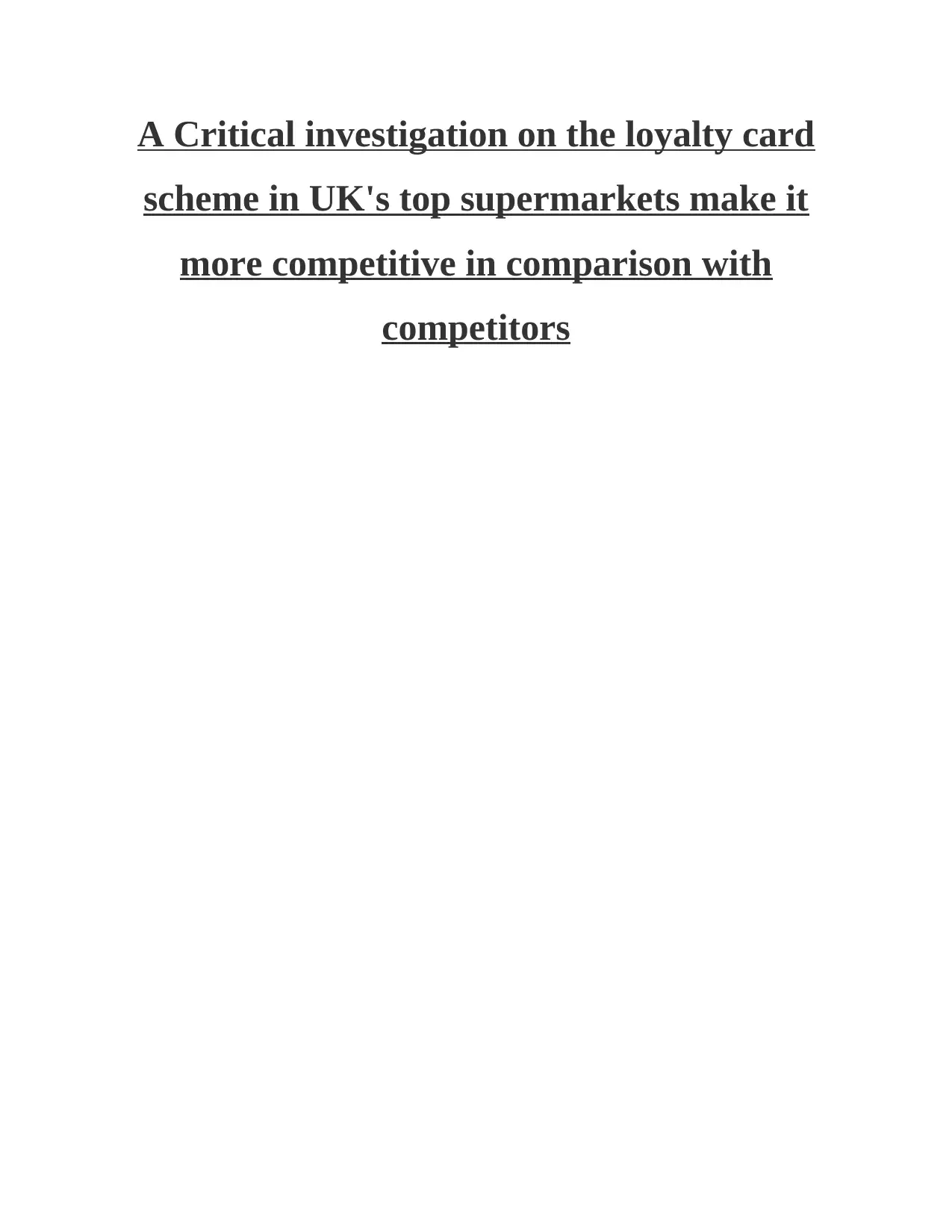
A Critical investigation on the loyalty card
scheme in UK's top supermarkets make it
more competitive in comparison with
competitors
scheme in UK's top supermarkets make it
more competitive in comparison with
competitors
Secure Best Marks with AI Grader
Need help grading? Try our AI Grader for instant feedback on your assignments.
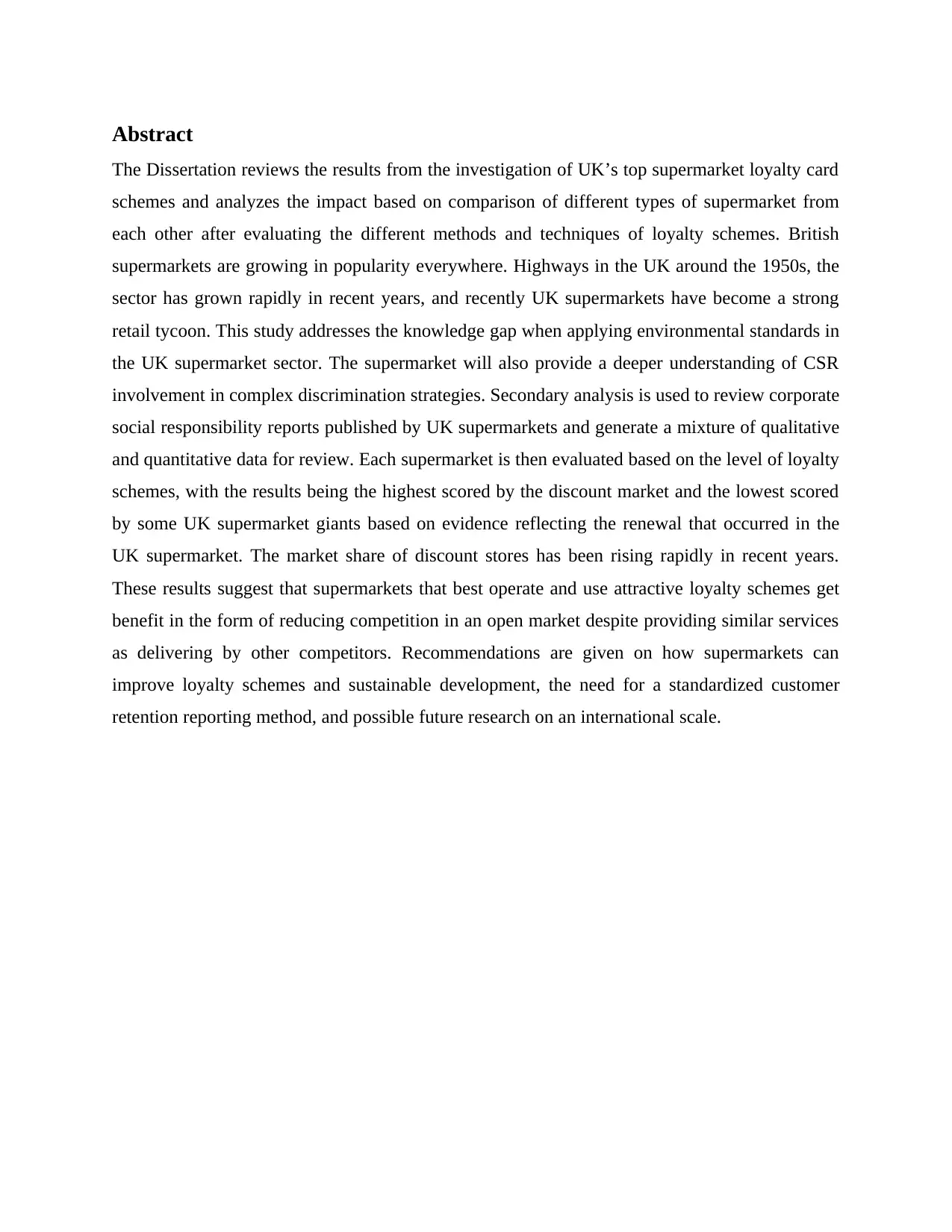
Abstract
The Dissertation reviews the results from the investigation of UK’s top supermarket loyalty card
schemes and analyzes the impact based on comparison of different types of supermarket from
each other after evaluating the different methods and techniques of loyalty schemes. British
supermarkets are growing in popularity everywhere. Highways in the UK around the 1950s, the
sector has grown rapidly in recent years, and recently UK supermarkets have become a strong
retail tycoon. This study addresses the knowledge gap when applying environmental standards in
the UK supermarket sector. The supermarket will also provide a deeper understanding of CSR
involvement in complex discrimination strategies. Secondary analysis is used to review corporate
social responsibility reports published by UK supermarkets and generate a mixture of qualitative
and quantitative data for review. Each supermarket is then evaluated based on the level of loyalty
schemes, with the results being the highest scored by the discount market and the lowest scored
by some UK supermarket giants based on evidence reflecting the renewal that occurred in the
UK supermarket. The market share of discount stores has been rising rapidly in recent years.
These results suggest that supermarkets that best operate and use attractive loyalty schemes get
benefit in the form of reducing competition in an open market despite providing similar services
as delivering by other competitors. Recommendations are given on how supermarkets can
improve loyalty schemes and sustainable development, the need for a standardized customer
retention reporting method, and possible future research on an international scale.
The Dissertation reviews the results from the investigation of UK’s top supermarket loyalty card
schemes and analyzes the impact based on comparison of different types of supermarket from
each other after evaluating the different methods and techniques of loyalty schemes. British
supermarkets are growing in popularity everywhere. Highways in the UK around the 1950s, the
sector has grown rapidly in recent years, and recently UK supermarkets have become a strong
retail tycoon. This study addresses the knowledge gap when applying environmental standards in
the UK supermarket sector. The supermarket will also provide a deeper understanding of CSR
involvement in complex discrimination strategies. Secondary analysis is used to review corporate
social responsibility reports published by UK supermarkets and generate a mixture of qualitative
and quantitative data for review. Each supermarket is then evaluated based on the level of loyalty
schemes, with the results being the highest scored by the discount market and the lowest scored
by some UK supermarket giants based on evidence reflecting the renewal that occurred in the
UK supermarket. The market share of discount stores has been rising rapidly in recent years.
These results suggest that supermarkets that best operate and use attractive loyalty schemes get
benefit in the form of reducing competition in an open market despite providing similar services
as delivering by other competitors. Recommendations are given on how supermarkets can
improve loyalty schemes and sustainable development, the need for a standardized customer
retention reporting method, and possible future research on an international scale.

Table of Contents
Abstract............................................................................................................................................2
Title: A critical investigation on the loyalty card scheme in UK’s top supermarket makes it more
competitive in comparison with the competitors.............................................................................5
1. INTRODUCTION.......................................................................................................................5
Research Aim:........................................................................................................................5
Research Questions:...............................................................................................................5
Research objectives................................................................................................................6
Rationale of the research........................................................................................................7
2. LITERATURE REVIEW............................................................................................................8
2.1 Different loyalty clubs scheme of UK top supermarket...................................................8
2.2 Impact of those loyalty club schemes on organisation strategies with competitor..........9
2.3 To visualise how the loyalty club schemes changes organisation strategies with
competition...........................................................................................................................10
2.4 To recommend new and improved strategies for loyalty schemes for UK top supermarket.
..............................................................................................................................................12
Conclusion.....................................................................................................................................14
3. Research Methodology..............................................................................................................15
3.1 Introduction....................................................................................................................15
3.2 Research methodologies.................................................................................................15
3.3 Research approach..........................................................................................................17
3.4 Quantitative and Qualitative approach...........................................................................17
3.5 Data collection methods.................................................................................................18
4. Analysis......................................................................................................................................19
4.1 Introduction....................................................................................................................19
4.2 Findings..........................................................................................................................19
Conclusion.....................................................................................................................................22
References......................................................................................................................................23
Abstract............................................................................................................................................2
Title: A critical investigation on the loyalty card scheme in UK’s top supermarket makes it more
competitive in comparison with the competitors.............................................................................5
1. INTRODUCTION.......................................................................................................................5
Research Aim:........................................................................................................................5
Research Questions:...............................................................................................................5
Research objectives................................................................................................................6
Rationale of the research........................................................................................................7
2. LITERATURE REVIEW............................................................................................................8
2.1 Different loyalty clubs scheme of UK top supermarket...................................................8
2.2 Impact of those loyalty club schemes on organisation strategies with competitor..........9
2.3 To visualise how the loyalty club schemes changes organisation strategies with
competition...........................................................................................................................10
2.4 To recommend new and improved strategies for loyalty schemes for UK top supermarket.
..............................................................................................................................................12
Conclusion.....................................................................................................................................14
3. Research Methodology..............................................................................................................15
3.1 Introduction....................................................................................................................15
3.2 Research methodologies.................................................................................................15
3.3 Research approach..........................................................................................................17
3.4 Quantitative and Qualitative approach...........................................................................17
3.5 Data collection methods.................................................................................................18
4. Analysis......................................................................................................................................19
4.1 Introduction....................................................................................................................19
4.2 Findings..........................................................................................................................19
Conclusion.....................................................................................................................................22
References......................................................................................................................................23

Paraphrase This Document
Need a fresh take? Get an instant paraphrase of this document with our AI Paraphraser
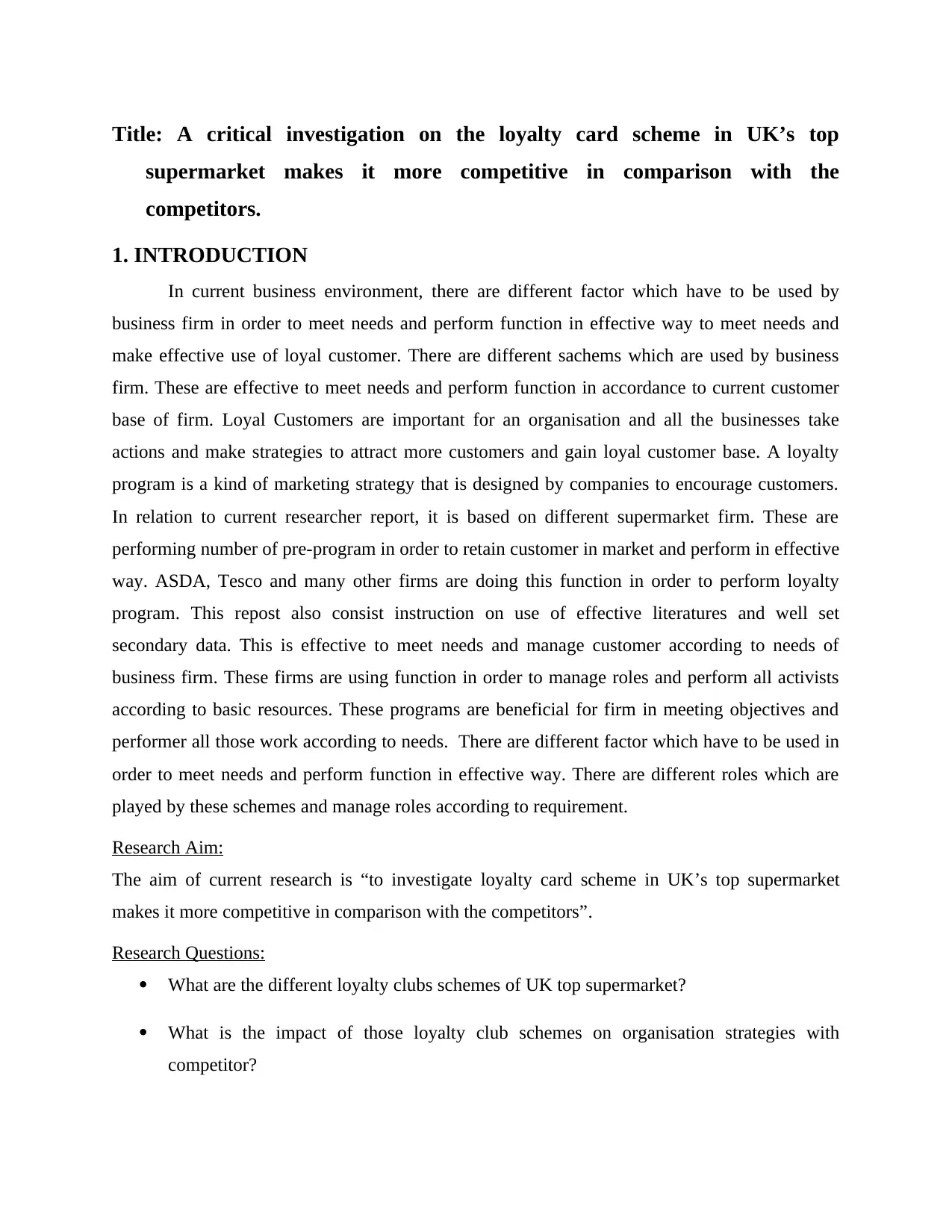
Title: A critical investigation on the loyalty card scheme in UK’s top
supermarket makes it more competitive in comparison with the
competitors.
1. INTRODUCTION
In current business environment, there are different factor which have to be used by
business firm in order to meet needs and perform function in effective way to meet needs and
make effective use of loyal customer. There are different sachems which are used by business
firm. These are effective to meet needs and perform function in accordance to current customer
base of firm. Loyal Customers are important for an organisation and all the businesses take
actions and make strategies to attract more customers and gain loyal customer base. A loyalty
program is a kind of marketing strategy that is designed by companies to encourage customers.
In relation to current researcher report, it is based on different supermarket firm. These are
performing number of pre-program in order to retain customer in market and perform in effective
way. ASDA, Tesco and many other firms are doing this function in order to perform loyalty
program. This repost also consist instruction on use of effective literatures and well set
secondary data. This is effective to meet needs and manage customer according to needs of
business firm. These firms are using function in order to manage roles and perform all activists
according to basic resources. These programs are beneficial for firm in meeting objectives and
performer all those work according to needs. There are different factor which have to be used in
order to meet needs and perform function in effective way. There are different roles which are
played by these schemes and manage roles according to requirement.
Research Aim:
The aim of current research is “to investigate loyalty card scheme in UK’s top supermarket
makes it more competitive in comparison with the competitors”.
Research Questions:
What are the different loyalty clubs schemes of UK top supermarket?
What is the impact of those loyalty club schemes on organisation strategies with
competitor?
supermarket makes it more competitive in comparison with the
competitors.
1. INTRODUCTION
In current business environment, there are different factor which have to be used by
business firm in order to meet needs and perform function in effective way to meet needs and
make effective use of loyal customer. There are different sachems which are used by business
firm. These are effective to meet needs and perform function in accordance to current customer
base of firm. Loyal Customers are important for an organisation and all the businesses take
actions and make strategies to attract more customers and gain loyal customer base. A loyalty
program is a kind of marketing strategy that is designed by companies to encourage customers.
In relation to current researcher report, it is based on different supermarket firm. These are
performing number of pre-program in order to retain customer in market and perform in effective
way. ASDA, Tesco and many other firms are doing this function in order to perform loyalty
program. This repost also consist instruction on use of effective literatures and well set
secondary data. This is effective to meet needs and manage customer according to needs of
business firm. These firms are using function in order to manage roles and perform all activists
according to basic resources. These programs are beneficial for firm in meeting objectives and
performer all those work according to needs. There are different factor which have to be used in
order to meet needs and perform function in effective way. There are different roles which are
played by these schemes and manage roles according to requirement.
Research Aim:
The aim of current research is “to investigate loyalty card scheme in UK’s top supermarket
makes it more competitive in comparison with the competitors”.
Research Questions:
What are the different loyalty clubs schemes of UK top supermarket?
What is the impact of those loyalty club schemes on organisation strategies with
competitor?

How loyalty club sachems changes organisation strategies with competition?
What are new and improved strategies for loyalty schemes for UK top supermarket?
Research objectives
To identify different loyalty clubs schemes of UK top supermarket
To evaluate the impact of those loyalty club schemes on organisation strategies with
competitor
To visualise the how loyalty club sachems changes organisation strategies with
competition
TO recommend new and improved strategies for loyalty schemes for UK top
supermarket.
Overview of the research
Loyalty schemes are important factor which is related to promoting function of firm
which helps in meeting needs and performing task in effective way. This is help full in meeting
needs and performing task according to needs. These are different factors which are used under
this report and manage roles according to function. This report consist discussion about different
factor where secondary data is used to meet objectives and perform all reviews. This is helpful in
meeting needs and performing all those function which helps business firm in meeting all those
function which helps in relating employees and building effective function. Under this, it also
includes discussion about data which is used by researcher to perform in effective way and meet
fulfil research objectives. Under this different literature will be used to review and manage data
which can be used to perform function and gain advantages according to needs. This is also
related to getting function which will helps in meeting all those reasons which are used to gain
information about different factor. This research also consist discussion about different factor
which will use to manage all data and perform function in effective way. There are various there
are different factors under this research report which are considered in order to ascertain the
objectives and perform the function and effectively. The research is placed on the incentive
What are new and improved strategies for loyalty schemes for UK top supermarket?
Research objectives
To identify different loyalty clubs schemes of UK top supermarket
To evaluate the impact of those loyalty club schemes on organisation strategies with
competitor
To visualise the how loyalty club sachems changes organisation strategies with
competition
TO recommend new and improved strategies for loyalty schemes for UK top
supermarket.
Overview of the research
Loyalty schemes are important factor which is related to promoting function of firm
which helps in meeting needs and performing task in effective way. This is help full in meeting
needs and performing task according to needs. These are different factors which are used under
this report and manage roles according to function. This report consist discussion about different
factor where secondary data is used to meet objectives and perform all reviews. This is helpful in
meeting needs and performing all those function which helps business firm in meeting all those
function which helps in relating employees and building effective function. Under this, it also
includes discussion about data which is used by researcher to perform in effective way and meet
fulfil research objectives. Under this different literature will be used to review and manage data
which can be used to perform function and gain advantages according to needs. This is also
related to getting function which will helps in meeting all those reasons which are used to gain
information about different factor. This research also consist discussion about different factor
which will use to manage all data and perform function in effective way. There are various there
are different factors under this research report which are considered in order to ascertain the
objectives and perform the function and effectively. The research is placed on the incentive
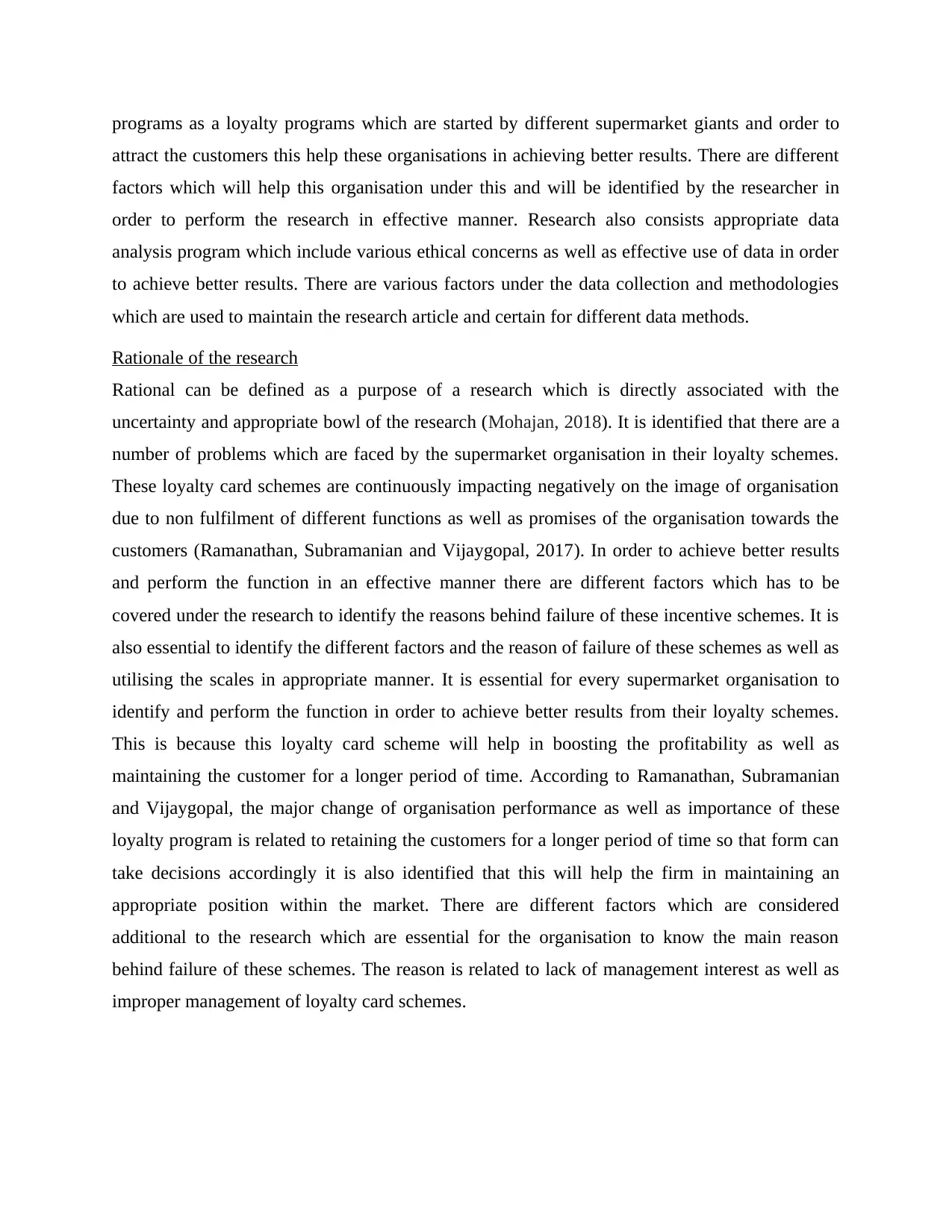
programs as a loyalty programs which are started by different supermarket giants and order to
attract the customers this help these organisations in achieving better results. There are different
factors which will help this organisation under this and will be identified by the researcher in
order to perform the research in effective manner. Research also consists appropriate data
analysis program which include various ethical concerns as well as effective use of data in order
to achieve better results. There are various factors under the data collection and methodologies
which are used to maintain the research article and certain for different data methods.
Rationale of the research
Rational can be defined as a purpose of a research which is directly associated with the
uncertainty and appropriate bowl of the research (Mohajan, 2018). It is identified that there are a
number of problems which are faced by the supermarket organisation in their loyalty schemes.
These loyalty card schemes are continuously impacting negatively on the image of organisation
due to non fulfilment of different functions as well as promises of the organisation towards the
customers (Ramanathan, Subramanian and Vijaygopal, 2017). In order to achieve better results
and perform the function in an effective manner there are different factors which has to be
covered under the research to identify the reasons behind failure of these incentive schemes. It is
also essential to identify the different factors and the reason of failure of these schemes as well as
utilising the scales in appropriate manner. It is essential for every supermarket organisation to
identify and perform the function in order to achieve better results from their loyalty schemes.
This is because this loyalty card scheme will help in boosting the profitability as well as
maintaining the customer for a longer period of time. According to Ramanathan, Subramanian
and Vijaygopal, the major change of organisation performance as well as importance of these
loyalty program is related to retaining the customers for a longer period of time so that form can
take decisions accordingly it is also identified that this will help the firm in maintaining an
appropriate position within the market. There are different factors which are considered
additional to the research which are essential for the organisation to know the main reason
behind failure of these schemes. The reason is related to lack of management interest as well as
improper management of loyalty card schemes.
attract the customers this help these organisations in achieving better results. There are different
factors which will help this organisation under this and will be identified by the researcher in
order to perform the research in effective manner. Research also consists appropriate data
analysis program which include various ethical concerns as well as effective use of data in order
to achieve better results. There are various factors under the data collection and methodologies
which are used to maintain the research article and certain for different data methods.
Rationale of the research
Rational can be defined as a purpose of a research which is directly associated with the
uncertainty and appropriate bowl of the research (Mohajan, 2018). It is identified that there are a
number of problems which are faced by the supermarket organisation in their loyalty schemes.
These loyalty card schemes are continuously impacting negatively on the image of organisation
due to non fulfilment of different functions as well as promises of the organisation towards the
customers (Ramanathan, Subramanian and Vijaygopal, 2017). In order to achieve better results
and perform the function in an effective manner there are different factors which has to be
covered under the research to identify the reasons behind failure of these incentive schemes. It is
also essential to identify the different factors and the reason of failure of these schemes as well as
utilising the scales in appropriate manner. It is essential for every supermarket organisation to
identify and perform the function in order to achieve better results from their loyalty schemes.
This is because this loyalty card scheme will help in boosting the profitability as well as
maintaining the customer for a longer period of time. According to Ramanathan, Subramanian
and Vijaygopal, the major change of organisation performance as well as importance of these
loyalty program is related to retaining the customers for a longer period of time so that form can
take decisions accordingly it is also identified that this will help the firm in maintaining an
appropriate position within the market. There are different factors which are considered
additional to the research which are essential for the organisation to know the main reason
behind failure of these schemes. The reason is related to lack of management interest as well as
improper management of loyalty card schemes.
Secure Best Marks with AI Grader
Need help grading? Try our AI Grader for instant feedback on your assignments.
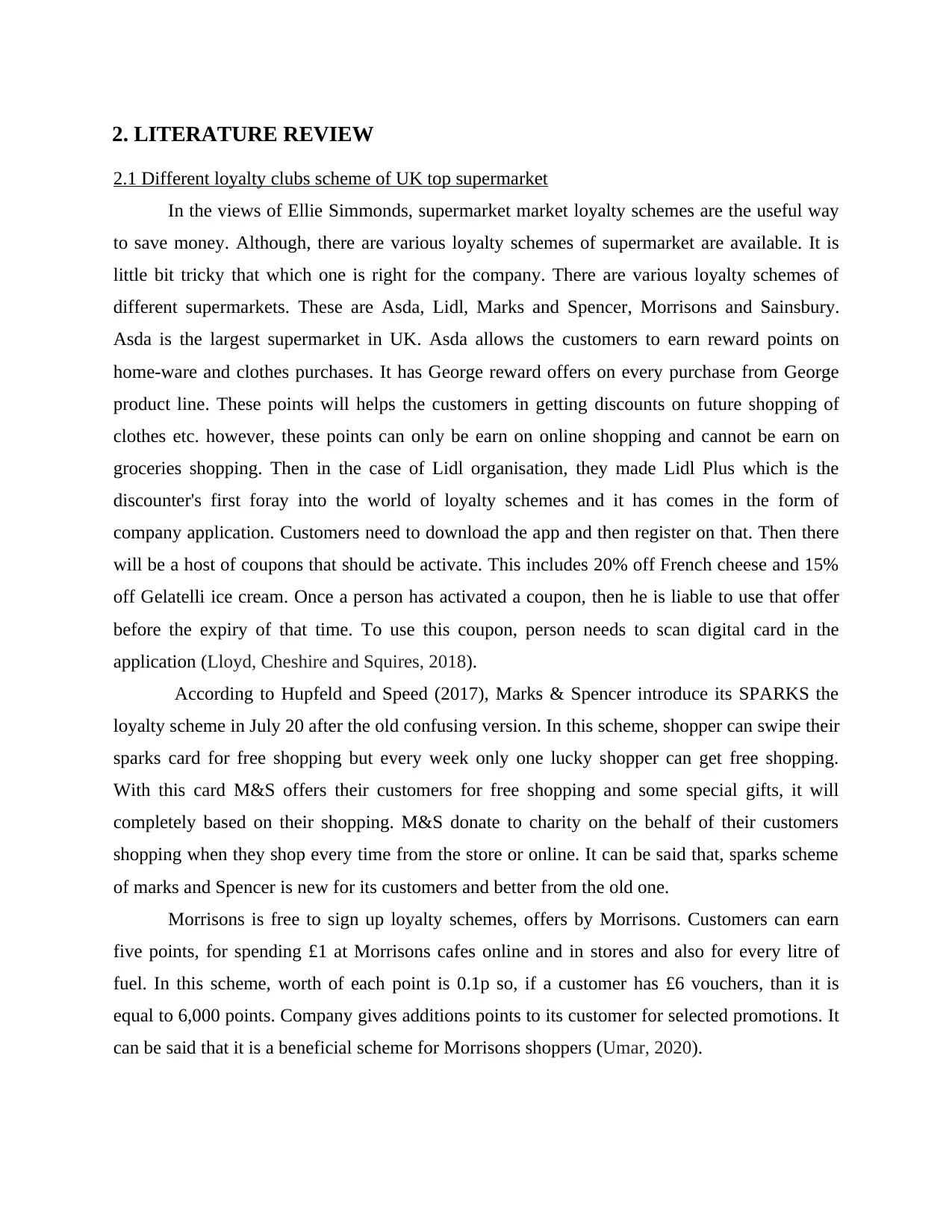
2. LITERATURE REVIEW
2.1 Different loyalty clubs scheme of UK top supermarket
In the views of Ellie Simmonds, supermarket market loyalty schemes are the useful way
to save money. Although, there are various loyalty schemes of supermarket are available. It is
little bit tricky that which one is right for the company. There are various loyalty schemes of
different supermarkets. These are Asda, Lidl, Marks and Spencer, Morrisons and Sainsbury.
Asda is the largest supermarket in UK. Asda allows the customers to earn reward points on
home-ware and clothes purchases. It has George reward offers on every purchase from George
product line. These points will helps the customers in getting discounts on future shopping of
clothes etc. however, these points can only be earn on online shopping and cannot be earn on
groceries shopping. Then in the case of Lidl organisation, they made Lidl Plus which is the
discounter's first foray into the world of loyalty schemes and it has comes in the form of
company application. Customers need to download the app and then register on that. Then there
will be a host of coupons that should be activate. This includes 20% off French cheese and 15%
off Gelatelli ice cream. Once a person has activated a coupon, then he is liable to use that offer
before the expiry of that time. To use this coupon, person needs to scan digital card in the
application (Lloyd, Cheshire and Squires, 2018).
According to Hupfeld and Speed (2017), Marks & Spencer introduce its SPARKS the
loyalty scheme in July 20 after the old confusing version. In this scheme, shopper can swipe their
sparks card for free shopping but every week only one lucky shopper can get free shopping.
With this card M&S offers their customers for free shopping and some special gifts, it will
completely based on their shopping. M&S donate to charity on the behalf of their customers
shopping when they shop every time from the store or online. It can be said that, sparks scheme
of marks and Spencer is new for its customers and better from the old one.
Morrisons is free to sign up loyalty schemes, offers by Morrisons. Customers can earn
five points, for spending £1 at Morrisons cafes online and in stores and also for every litre of
fuel. In this scheme, worth of each point is 0.1p so, if a customer has £6 vouchers, than it is
equal to 6,000 points. Company gives additions points to its customer for selected promotions. It
can be said that it is a beneficial scheme for Morrisons shoppers (Umar, 2020).
2.1 Different loyalty clubs scheme of UK top supermarket
In the views of Ellie Simmonds, supermarket market loyalty schemes are the useful way
to save money. Although, there are various loyalty schemes of supermarket are available. It is
little bit tricky that which one is right for the company. There are various loyalty schemes of
different supermarkets. These are Asda, Lidl, Marks and Spencer, Morrisons and Sainsbury.
Asda is the largest supermarket in UK. Asda allows the customers to earn reward points on
home-ware and clothes purchases. It has George reward offers on every purchase from George
product line. These points will helps the customers in getting discounts on future shopping of
clothes etc. however, these points can only be earn on online shopping and cannot be earn on
groceries shopping. Then in the case of Lidl organisation, they made Lidl Plus which is the
discounter's first foray into the world of loyalty schemes and it has comes in the form of
company application. Customers need to download the app and then register on that. Then there
will be a host of coupons that should be activate. This includes 20% off French cheese and 15%
off Gelatelli ice cream. Once a person has activated a coupon, then he is liable to use that offer
before the expiry of that time. To use this coupon, person needs to scan digital card in the
application (Lloyd, Cheshire and Squires, 2018).
According to Hupfeld and Speed (2017), Marks & Spencer introduce its SPARKS the
loyalty scheme in July 20 after the old confusing version. In this scheme, shopper can swipe their
sparks card for free shopping but every week only one lucky shopper can get free shopping.
With this card M&S offers their customers for free shopping and some special gifts, it will
completely based on their shopping. M&S donate to charity on the behalf of their customers
shopping when they shop every time from the store or online. It can be said that, sparks scheme
of marks and Spencer is new for its customers and better from the old one.
Morrisons is free to sign up loyalty schemes, offers by Morrisons. Customers can earn
five points, for spending £1 at Morrisons cafes online and in stores and also for every litre of
fuel. In this scheme, worth of each point is 0.1p so, if a customer has £6 vouchers, than it is
equal to 6,000 points. Company gives additions points to its customer for selected promotions. It
can be said that it is a beneficial scheme for Morrisons shoppers (Umar, 2020).
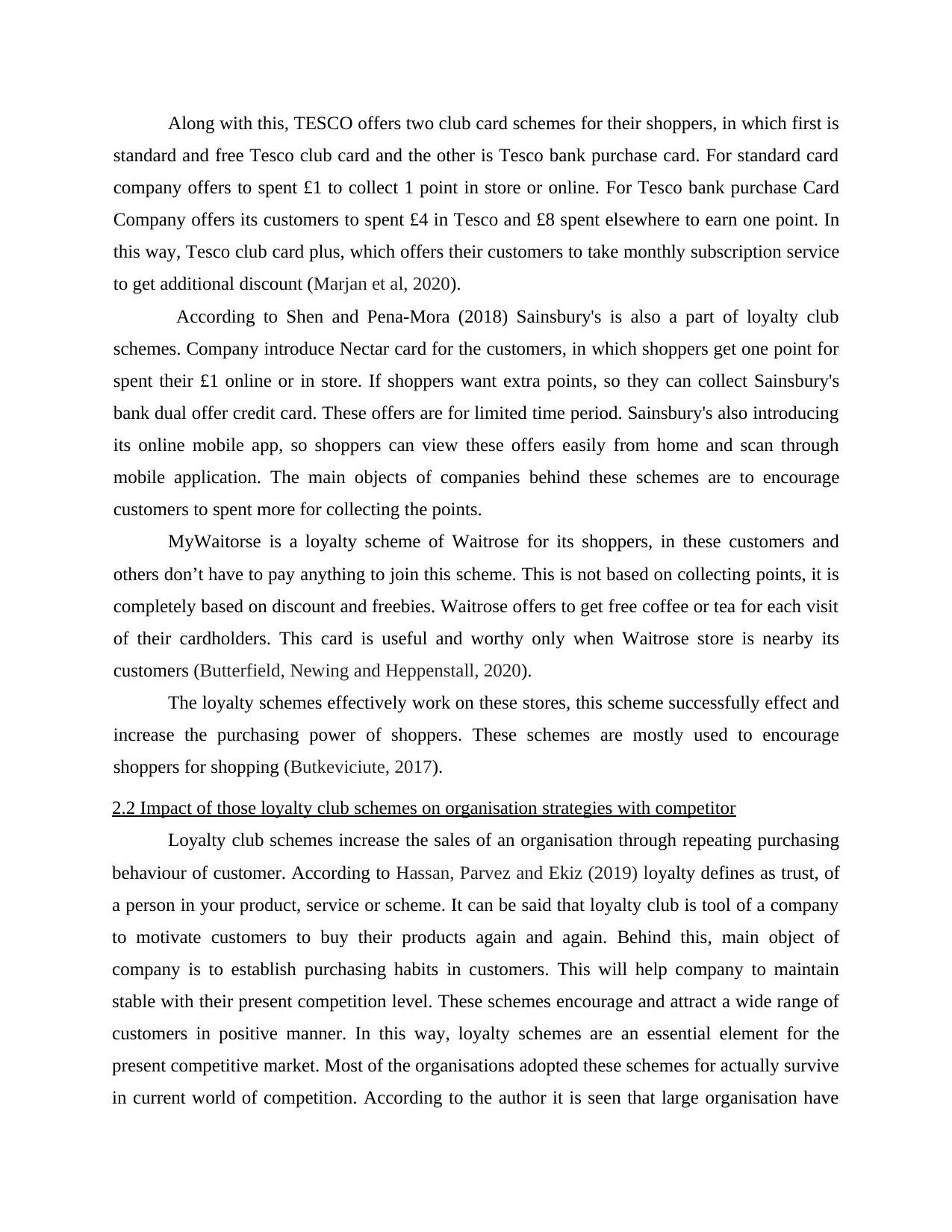
Along with this, TESCO offers two club card schemes for their shoppers, in which first is
standard and free Tesco club card and the other is Tesco bank purchase card. For standard card
company offers to spent £1 to collect 1 point in store or online. For Tesco bank purchase Card
Company offers its customers to spent £4 in Tesco and £8 spent elsewhere to earn one point. In
this way, Tesco club card plus, which offers their customers to take monthly subscription service
to get additional discount (Marjan et al, 2020).
According to Shen and Pena-Mora (2018) Sainsbury's is also a part of loyalty club
schemes. Company introduce Nectar card for the customers, in which shoppers get one point for
spent their £1 online or in store. If shoppers want extra points, so they can collect Sainsbury's
bank dual offer credit card. These offers are for limited time period. Sainsbury's also introducing
its online mobile app, so shoppers can view these offers easily from home and scan through
mobile application. The main objects of companies behind these schemes are to encourage
customers to spent more for collecting the points.
MyWaitorse is a loyalty scheme of Waitrose for its shoppers, in these customers and
others don’t have to pay anything to join this scheme. This is not based on collecting points, it is
completely based on discount and freebies. Waitrose offers to get free coffee or tea for each visit
of their cardholders. This card is useful and worthy only when Waitrose store is nearby its
customers (Butterfield, Newing and Heppenstall, 2020).
The loyalty schemes effectively work on these stores, this scheme successfully effect and
increase the purchasing power of shoppers. These schemes are mostly used to encourage
shoppers for shopping (Butkeviciute, 2017).
2.2 Impact of those loyalty club schemes on organisation strategies with competitor
Loyalty club schemes increase the sales of an organisation through repeating purchasing
behaviour of customer. According to Hassan, Parvez and Ekiz (2019) loyalty defines as trust, of
a person in your product, service or scheme. It can be said that loyalty club is tool of a company
to motivate customers to buy their products again and again. Behind this, main object of
company is to establish purchasing habits in customers. This will help company to maintain
stable with their present competition level. These schemes encourage and attract a wide range of
customers in positive manner. In this way, loyalty schemes are an essential element for the
present competitive market. Most of the organisations adopted these schemes for actually survive
in current world of competition. According to the author it is seen that large organisation have
standard and free Tesco club card and the other is Tesco bank purchase card. For standard card
company offers to spent £1 to collect 1 point in store or online. For Tesco bank purchase Card
Company offers its customers to spent £4 in Tesco and £8 spent elsewhere to earn one point. In
this way, Tesco club card plus, which offers their customers to take monthly subscription service
to get additional discount (Marjan et al, 2020).
According to Shen and Pena-Mora (2018) Sainsbury's is also a part of loyalty club
schemes. Company introduce Nectar card for the customers, in which shoppers get one point for
spent their £1 online or in store. If shoppers want extra points, so they can collect Sainsbury's
bank dual offer credit card. These offers are for limited time period. Sainsbury's also introducing
its online mobile app, so shoppers can view these offers easily from home and scan through
mobile application. The main objects of companies behind these schemes are to encourage
customers to spent more for collecting the points.
MyWaitorse is a loyalty scheme of Waitrose for its shoppers, in these customers and
others don’t have to pay anything to join this scheme. This is not based on collecting points, it is
completely based on discount and freebies. Waitrose offers to get free coffee or tea for each visit
of their cardholders. This card is useful and worthy only when Waitrose store is nearby its
customers (Butterfield, Newing and Heppenstall, 2020).
The loyalty schemes effectively work on these stores, this scheme successfully effect and
increase the purchasing power of shoppers. These schemes are mostly used to encourage
shoppers for shopping (Butkeviciute, 2017).
2.2 Impact of those loyalty club schemes on organisation strategies with competitor
Loyalty club schemes increase the sales of an organisation through repeating purchasing
behaviour of customer. According to Hassan, Parvez and Ekiz (2019) loyalty defines as trust, of
a person in your product, service or scheme. It can be said that loyalty club is tool of a company
to motivate customers to buy their products again and again. Behind this, main object of
company is to establish purchasing habits in customers. This will help company to maintain
stable with their present competition level. These schemes encourage and attract a wide range of
customers in positive manner. In this way, loyalty schemes are an essential element for the
present competitive market. Most of the organisations adopted these schemes for actually survive
in current world of competition. According to the author it is seen that large organisation have
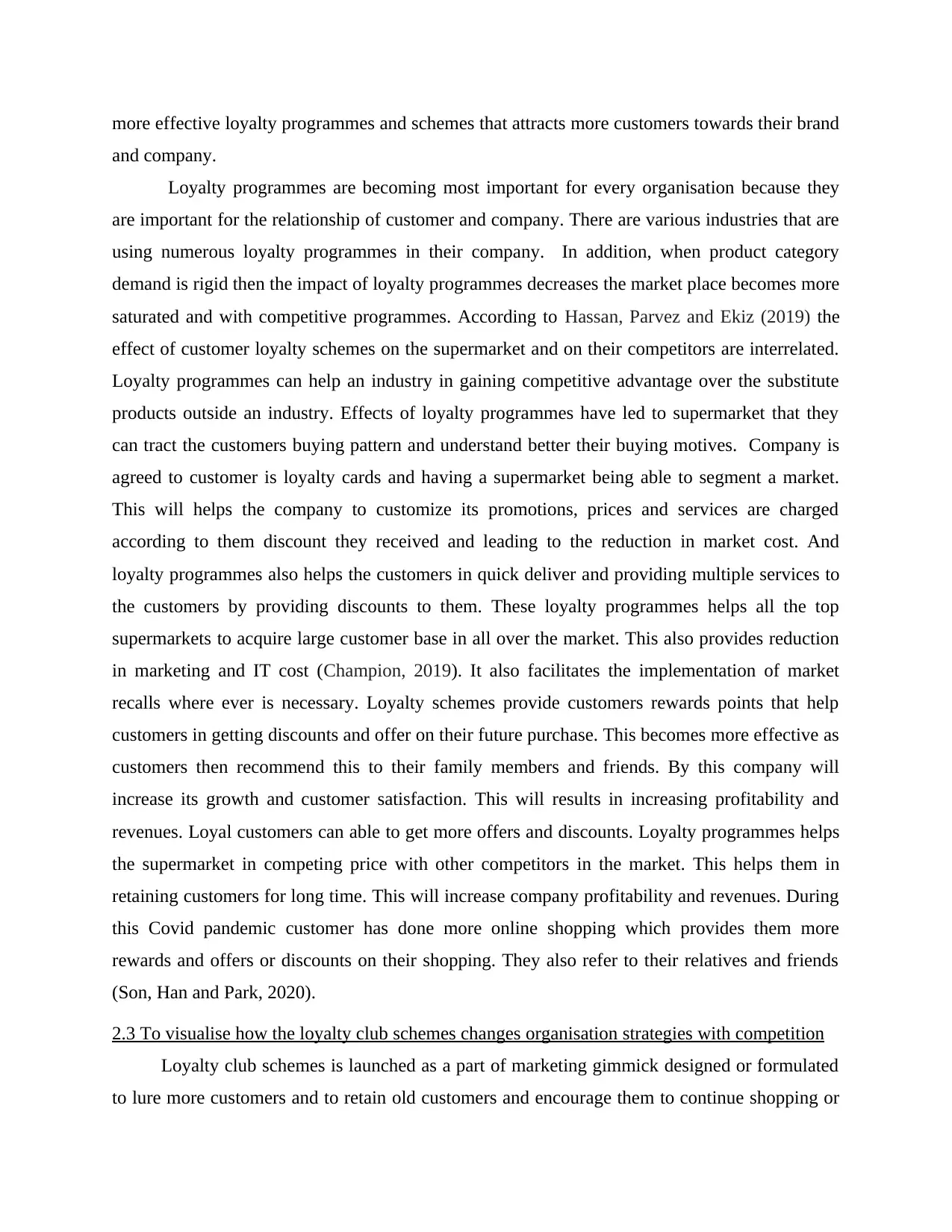
more effective loyalty programmes and schemes that attracts more customers towards their brand
and company.
Loyalty programmes are becoming most important for every organisation because they
are important for the relationship of customer and company. There are various industries that are
using numerous loyalty programmes in their company. In addition, when product category
demand is rigid then the impact of loyalty programmes decreases the market place becomes more
saturated and with competitive programmes. According to Hassan, Parvez and Ekiz (2019) the
effect of customer loyalty schemes on the supermarket and on their competitors are interrelated.
Loyalty programmes can help an industry in gaining competitive advantage over the substitute
products outside an industry. Effects of loyalty programmes have led to supermarket that they
can tract the customers buying pattern and understand better their buying motives. Company is
agreed to customer is loyalty cards and having a supermarket being able to segment a market.
This will helps the company to customize its promotions, prices and services are charged
according to them discount they received and leading to the reduction in market cost. And
loyalty programmes also helps the customers in quick deliver and providing multiple services to
the customers by providing discounts to them. These loyalty programmes helps all the top
supermarkets to acquire large customer base in all over the market. This also provides reduction
in marketing and IT cost (Champion, 2019). It also facilitates the implementation of market
recalls where ever is necessary. Loyalty schemes provide customers rewards points that help
customers in getting discounts and offer on their future purchase. This becomes more effective as
customers then recommend this to their family members and friends. By this company will
increase its growth and customer satisfaction. This will results in increasing profitability and
revenues. Loyal customers can able to get more offers and discounts. Loyalty programmes helps
the supermarket in competing price with other competitors in the market. This helps them in
retaining customers for long time. This will increase company profitability and revenues. During
this Covid pandemic customer has done more online shopping which provides them more
rewards and offers or discounts on their shopping. They also refer to their relatives and friends
(Son, Han and Park, 2020).
2.3 To visualise how the loyalty club schemes changes organisation strategies with competition
Loyalty club schemes is launched as a part of marketing gimmick designed or formulated
to lure more customers and to retain old customers and encourage them to continue shopping or
and company.
Loyalty programmes are becoming most important for every organisation because they
are important for the relationship of customer and company. There are various industries that are
using numerous loyalty programmes in their company. In addition, when product category
demand is rigid then the impact of loyalty programmes decreases the market place becomes more
saturated and with competitive programmes. According to Hassan, Parvez and Ekiz (2019) the
effect of customer loyalty schemes on the supermarket and on their competitors are interrelated.
Loyalty programmes can help an industry in gaining competitive advantage over the substitute
products outside an industry. Effects of loyalty programmes have led to supermarket that they
can tract the customers buying pattern and understand better their buying motives. Company is
agreed to customer is loyalty cards and having a supermarket being able to segment a market.
This will helps the company to customize its promotions, prices and services are charged
according to them discount they received and leading to the reduction in market cost. And
loyalty programmes also helps the customers in quick deliver and providing multiple services to
the customers by providing discounts to them. These loyalty programmes helps all the top
supermarkets to acquire large customer base in all over the market. This also provides reduction
in marketing and IT cost (Champion, 2019). It also facilitates the implementation of market
recalls where ever is necessary. Loyalty schemes provide customers rewards points that help
customers in getting discounts and offer on their future purchase. This becomes more effective as
customers then recommend this to their family members and friends. By this company will
increase its growth and customer satisfaction. This will results in increasing profitability and
revenues. Loyal customers can able to get more offers and discounts. Loyalty programmes helps
the supermarket in competing price with other competitors in the market. This helps them in
retaining customers for long time. This will increase company profitability and revenues. During
this Covid pandemic customer has done more online shopping which provides them more
rewards and offers or discounts on their shopping. They also refer to their relatives and friends
(Son, Han and Park, 2020).
2.3 To visualise how the loyalty club schemes changes organisation strategies with competition
Loyalty club schemes is launched as a part of marketing gimmick designed or formulated
to lure more customers and to retain old customers and encourage them to continue shopping or
Paraphrase This Document
Need a fresh take? Get an instant paraphrase of this document with our AI Paraphraser

using services of business or organisation associated with that program. Basically in this program
customers are provided with a card which is record of points they own allotted to them when
they purchased any product or used services of business associated with the program. The
customer can use those points for getting discounts on current purchases as well as on future
purchases. A particular individual in UK owns approximately 17 loyalty card in their digital
wallets. Following are the strategies related to loyalty club program.
Organisation can have enough information to better understand existing customer
preferences and their community group:- Gaining enough information related to customers taste,
preferences, their age group and society they belongs to will definitely provides company clear
vision related to how to retain existing customer by alluring them with overwhelming discounts
offer and voucher and also to take future steps related to taking growth step in market. Loyalty
club program is used differently in different sectors. For instance Tesco which is among the
largest grocery and general merchandise company worldwide uses loyalty cards so that they can
better retain their existing customers and also to allure their new customers. They provides
varied discount on clothing and online purchased groceries which can be redeemed by the points
allotted to them on every purchase. Whereas in financial service sector company uses loyalty
card as a base of insights and information so that they can accurately understand customer
choices, their short term and long term goals, their financial needs and wants and use these
insights for reaching more customers (Zielke and Komor, 2020).
Loyalty program should be open nature in nature so that it can stand out from the crowd
and also acceptable by wide range of customers: - openness here refers to programs adaptability
to work with others. Program should not be in rigid in nature rather it should be dynamic in
nature which can also work with others who are also preferable by crowd. Now a day’s all
loyalty program related to particular business is already becoming more open in nature which is
derived as per customer demand. For instance we can understand this with the example of
Amazon. Amazon's program is already working with many top business organisation i.e. Paytm,
Google pay and many others. On using Google pay or any other digital wallet for transferring
money to your peer’s customer can receive Amazon vouchers which they can use to get
discounts on future purchase on Amazon. In this way they attracting more and more customers
working together and also earning enough profits for each organisation (Alshurideh et al, 2020).
customers are provided with a card which is record of points they own allotted to them when
they purchased any product or used services of business associated with the program. The
customer can use those points for getting discounts on current purchases as well as on future
purchases. A particular individual in UK owns approximately 17 loyalty card in their digital
wallets. Following are the strategies related to loyalty club program.
Organisation can have enough information to better understand existing customer
preferences and their community group:- Gaining enough information related to customers taste,
preferences, their age group and society they belongs to will definitely provides company clear
vision related to how to retain existing customer by alluring them with overwhelming discounts
offer and voucher and also to take future steps related to taking growth step in market. Loyalty
club program is used differently in different sectors. For instance Tesco which is among the
largest grocery and general merchandise company worldwide uses loyalty cards so that they can
better retain their existing customers and also to allure their new customers. They provides
varied discount on clothing and online purchased groceries which can be redeemed by the points
allotted to them on every purchase. Whereas in financial service sector company uses loyalty
card as a base of insights and information so that they can accurately understand customer
choices, their short term and long term goals, their financial needs and wants and use these
insights for reaching more customers (Zielke and Komor, 2020).
Loyalty program should be open nature in nature so that it can stand out from the crowd
and also acceptable by wide range of customers: - openness here refers to programs adaptability
to work with others. Program should not be in rigid in nature rather it should be dynamic in
nature which can also work with others who are also preferable by crowd. Now a day’s all
loyalty program related to particular business is already becoming more open in nature which is
derived as per customer demand. For instance we can understand this with the example of
Amazon. Amazon's program is already working with many top business organisation i.e. Paytm,
Google pay and many others. On using Google pay or any other digital wallet for transferring
money to your peer’s customer can receive Amazon vouchers which they can use to get
discounts on future purchase on Amazon. In this way they attracting more and more customers
working together and also earning enough profits for each organisation (Alshurideh et al, 2020).
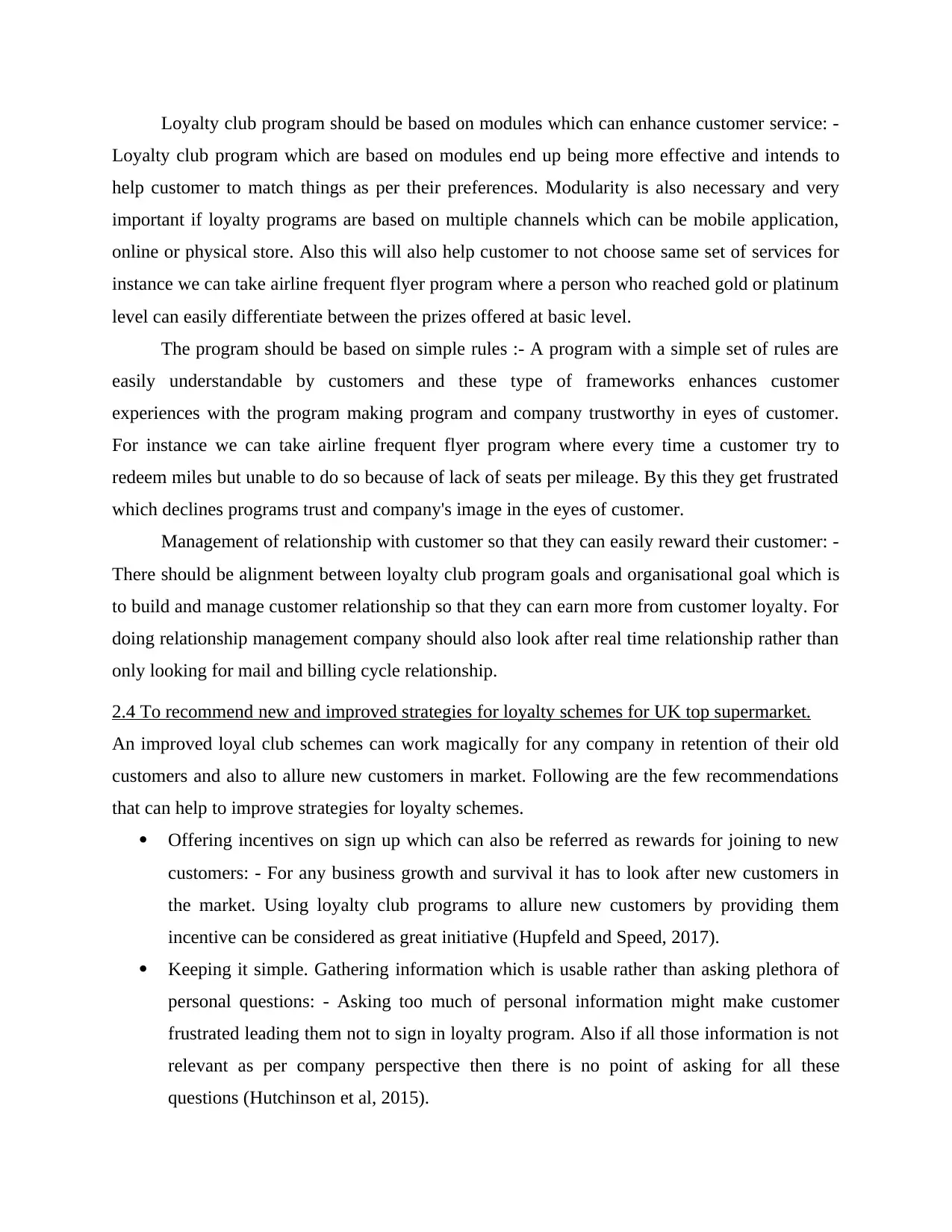
Loyalty club program should be based on modules which can enhance customer service: -
Loyalty club program which are based on modules end up being more effective and intends to
help customer to match things as per their preferences. Modularity is also necessary and very
important if loyalty programs are based on multiple channels which can be mobile application,
online or physical store. Also this will also help customer to not choose same set of services for
instance we can take airline frequent flyer program where a person who reached gold or platinum
level can easily differentiate between the prizes offered at basic level.
The program should be based on simple rules :- A program with a simple set of rules are
easily understandable by customers and these type of frameworks enhances customer
experiences with the program making program and company trustworthy in eyes of customer.
For instance we can take airline frequent flyer program where every time a customer try to
redeem miles but unable to do so because of lack of seats per mileage. By this they get frustrated
which declines programs trust and company's image in the eyes of customer.
Management of relationship with customer so that they can easily reward their customer: -
There should be alignment between loyalty club program goals and organisational goal which is
to build and manage customer relationship so that they can earn more from customer loyalty. For
doing relationship management company should also look after real time relationship rather than
only looking for mail and billing cycle relationship.
2.4 To recommend new and improved strategies for loyalty schemes for UK top supermarket.
An improved loyal club schemes can work magically for any company in retention of their old
customers and also to allure new customers in market. Following are the few recommendations
that can help to improve strategies for loyalty schemes.
Offering incentives on sign up which can also be referred as rewards for joining to new
customers: - For any business growth and survival it has to look after new customers in
the market. Using loyalty club programs to allure new customers by providing them
incentive can be considered as great initiative (Hupfeld and Speed, 2017).
Keeping it simple. Gathering information which is usable rather than asking plethora of
personal questions: - Asking too much of personal information might make customer
frustrated leading them not to sign in loyalty program. Also if all those information is not
relevant as per company perspective then there is no point of asking for all these
questions (Hutchinson et al, 2015).
Loyalty club program which are based on modules end up being more effective and intends to
help customer to match things as per their preferences. Modularity is also necessary and very
important if loyalty programs are based on multiple channels which can be mobile application,
online or physical store. Also this will also help customer to not choose same set of services for
instance we can take airline frequent flyer program where a person who reached gold or platinum
level can easily differentiate between the prizes offered at basic level.
The program should be based on simple rules :- A program with a simple set of rules are
easily understandable by customers and these type of frameworks enhances customer
experiences with the program making program and company trustworthy in eyes of customer.
For instance we can take airline frequent flyer program where every time a customer try to
redeem miles but unable to do so because of lack of seats per mileage. By this they get frustrated
which declines programs trust and company's image in the eyes of customer.
Management of relationship with customer so that they can easily reward their customer: -
There should be alignment between loyalty club program goals and organisational goal which is
to build and manage customer relationship so that they can earn more from customer loyalty. For
doing relationship management company should also look after real time relationship rather than
only looking for mail and billing cycle relationship.
2.4 To recommend new and improved strategies for loyalty schemes for UK top supermarket.
An improved loyal club schemes can work magically for any company in retention of their old
customers and also to allure new customers in market. Following are the few recommendations
that can help to improve strategies for loyalty schemes.
Offering incentives on sign up which can also be referred as rewards for joining to new
customers: - For any business growth and survival it has to look after new customers in
the market. Using loyalty club programs to allure new customers by providing them
incentive can be considered as great initiative (Hupfeld and Speed, 2017).
Keeping it simple. Gathering information which is usable rather than asking plethora of
personal questions: - Asking too much of personal information might make customer
frustrated leading them not to sign in loyalty program. Also if all those information is not
relevant as per company perspective then there is no point of asking for all these
questions (Hutchinson et al, 2015).
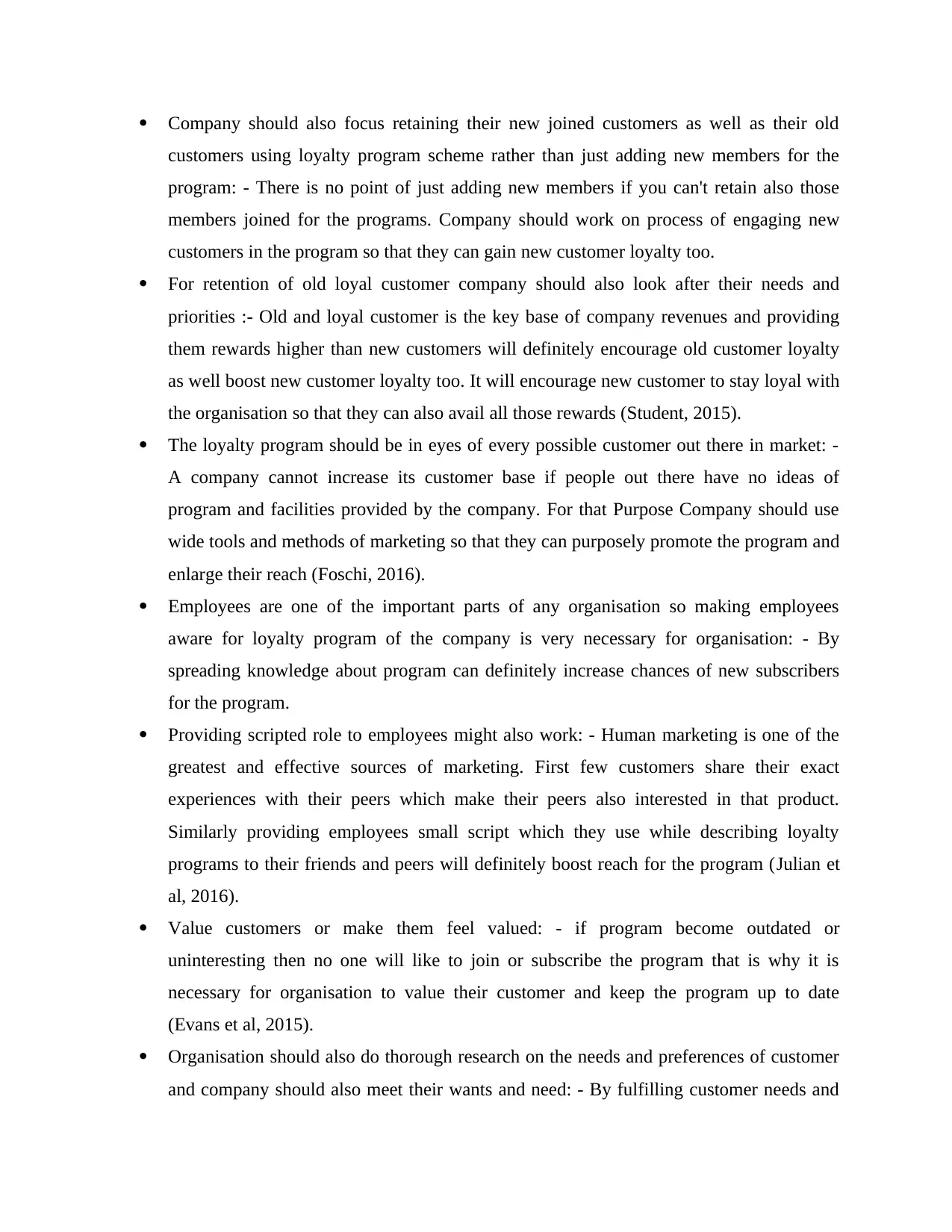
Company should also focus retaining their new joined customers as well as their old
customers using loyalty program scheme rather than just adding new members for the
program: - There is no point of just adding new members if you can't retain also those
members joined for the programs. Company should work on process of engaging new
customers in the program so that they can gain new customer loyalty too.
For retention of old loyal customer company should also look after their needs and
priorities :- Old and loyal customer is the key base of company revenues and providing
them rewards higher than new customers will definitely encourage old customer loyalty
as well boost new customer loyalty too. It will encourage new customer to stay loyal with
the organisation so that they can also avail all those rewards (Student, 2015).
The loyalty program should be in eyes of every possible customer out there in market: -
A company cannot increase its customer base if people out there have no ideas of
program and facilities provided by the company. For that Purpose Company should use
wide tools and methods of marketing so that they can purposely promote the program and
enlarge their reach (Foschi, 2016).
Employees are one of the important parts of any organisation so making employees
aware for loyalty program of the company is very necessary for organisation: - By
spreading knowledge about program can definitely increase chances of new subscribers
for the program.
Providing scripted role to employees might also work: - Human marketing is one of the
greatest and effective sources of marketing. First few customers share their exact
experiences with their peers which make their peers also interested in that product.
Similarly providing employees small script which they use while describing loyalty
programs to their friends and peers will definitely boost reach for the program (Julian et
al, 2016).
Value customers or make them feel valued: - if program become outdated or
uninteresting then no one will like to join or subscribe the program that is why it is
necessary for organisation to value their customer and keep the program up to date
(Evans et al, 2015).
Organisation should also do thorough research on the needs and preferences of customer
and company should also meet their wants and need: - By fulfilling customer needs and
customers using loyalty program scheme rather than just adding new members for the
program: - There is no point of just adding new members if you can't retain also those
members joined for the programs. Company should work on process of engaging new
customers in the program so that they can gain new customer loyalty too.
For retention of old loyal customer company should also look after their needs and
priorities :- Old and loyal customer is the key base of company revenues and providing
them rewards higher than new customers will definitely encourage old customer loyalty
as well boost new customer loyalty too. It will encourage new customer to stay loyal with
the organisation so that they can also avail all those rewards (Student, 2015).
The loyalty program should be in eyes of every possible customer out there in market: -
A company cannot increase its customer base if people out there have no ideas of
program and facilities provided by the company. For that Purpose Company should use
wide tools and methods of marketing so that they can purposely promote the program and
enlarge their reach (Foschi, 2016).
Employees are one of the important parts of any organisation so making employees
aware for loyalty program of the company is very necessary for organisation: - By
spreading knowledge about program can definitely increase chances of new subscribers
for the program.
Providing scripted role to employees might also work: - Human marketing is one of the
greatest and effective sources of marketing. First few customers share their exact
experiences with their peers which make their peers also interested in that product.
Similarly providing employees small script which they use while describing loyalty
programs to their friends and peers will definitely boost reach for the program (Julian et
al, 2016).
Value customers or make them feel valued: - if program become outdated or
uninteresting then no one will like to join or subscribe the program that is why it is
necessary for organisation to value their customer and keep the program up to date
(Evans et al, 2015).
Organisation should also do thorough research on the needs and preferences of customer
and company should also meet their wants and need: - By fulfilling customer needs and
Secure Best Marks with AI Grader
Need help grading? Try our AI Grader for instant feedback on your assignments.

wants organisation can retain their customers and also grab some new ones (Foschi,
2017).
2017).
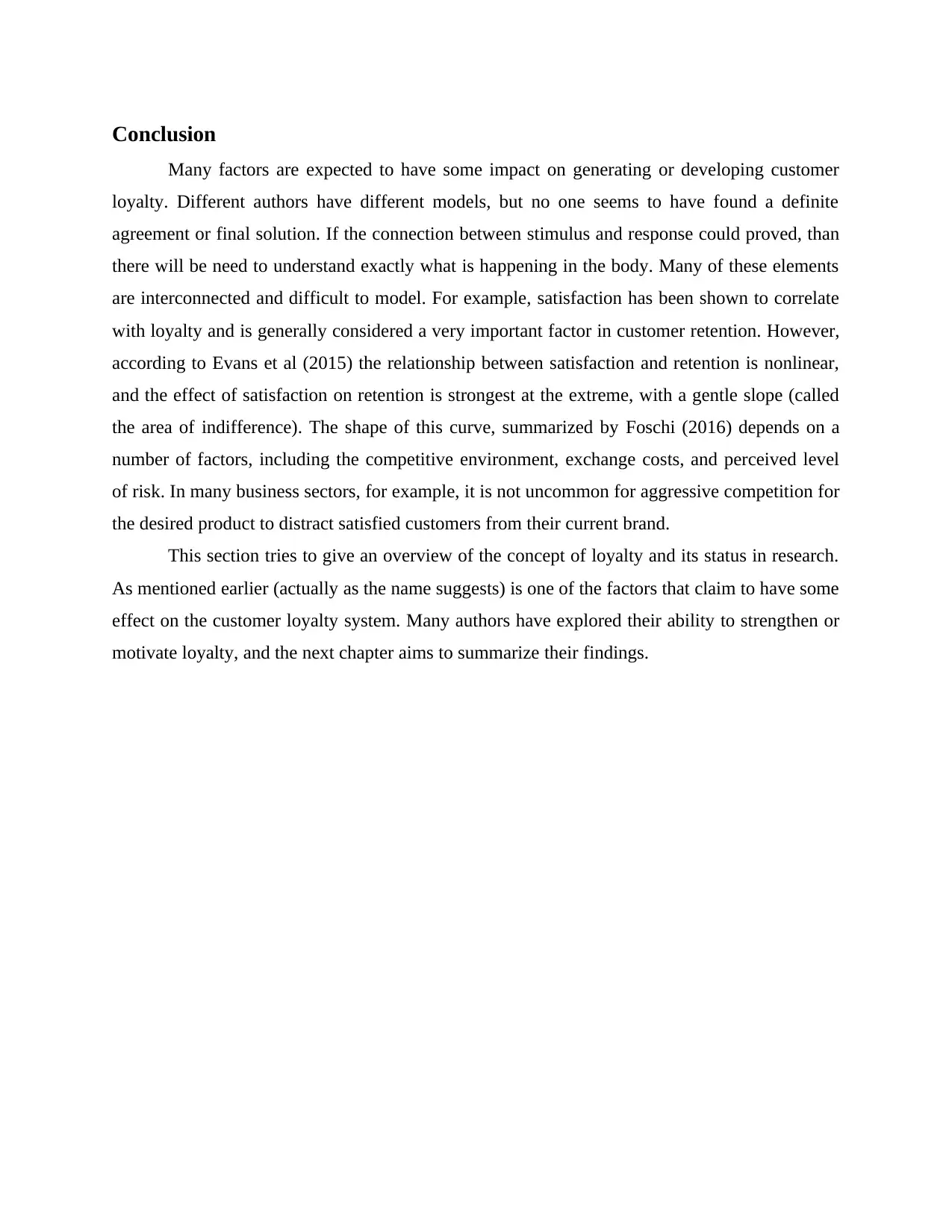
Conclusion
Many factors are expected to have some impact on generating or developing customer
loyalty. Different authors have different models, but no one seems to have found a definite
agreement or final solution. If the connection between stimulus and response could proved, than
there will be need to understand exactly what is happening in the body. Many of these elements
are interconnected and difficult to model. For example, satisfaction has been shown to correlate
with loyalty and is generally considered a very important factor in customer retention. However,
according to Evans et al (2015) the relationship between satisfaction and retention is nonlinear,
and the effect of satisfaction on retention is strongest at the extreme, with a gentle slope (called
the area of indifference). The shape of this curve, summarized by Foschi (2016) depends on a
number of factors, including the competitive environment, exchange costs, and perceived level
of risk. In many business sectors, for example, it is not uncommon for aggressive competition for
the desired product to distract satisfied customers from their current brand.
This section tries to give an overview of the concept of loyalty and its status in research.
As mentioned earlier (actually as the name suggests) is one of the factors that claim to have some
effect on the customer loyalty system. Many authors have explored their ability to strengthen or
motivate loyalty, and the next chapter aims to summarize their findings.
Many factors are expected to have some impact on generating or developing customer
loyalty. Different authors have different models, but no one seems to have found a definite
agreement or final solution. If the connection between stimulus and response could proved, than
there will be need to understand exactly what is happening in the body. Many of these elements
are interconnected and difficult to model. For example, satisfaction has been shown to correlate
with loyalty and is generally considered a very important factor in customer retention. However,
according to Evans et al (2015) the relationship between satisfaction and retention is nonlinear,
and the effect of satisfaction on retention is strongest at the extreme, with a gentle slope (called
the area of indifference). The shape of this curve, summarized by Foschi (2016) depends on a
number of factors, including the competitive environment, exchange costs, and perceived level
of risk. In many business sectors, for example, it is not uncommon for aggressive competition for
the desired product to distract satisfied customers from their current brand.
This section tries to give an overview of the concept of loyalty and its status in research.
As mentioned earlier (actually as the name suggests) is one of the factors that claim to have some
effect on the customer loyalty system. Many authors have explored their ability to strengthen or
motivate loyalty, and the next chapter aims to summarize their findings.
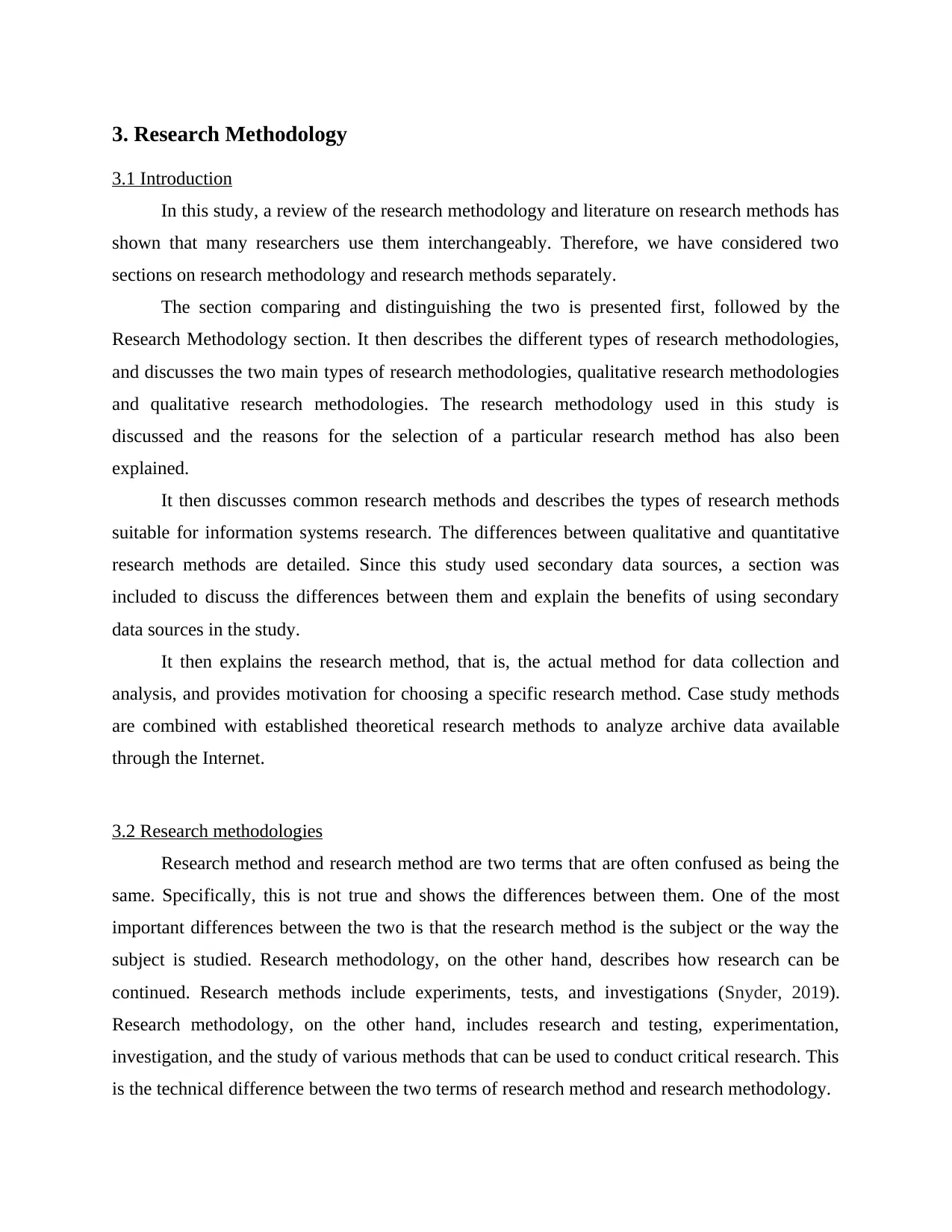
3. Research Methodology
3.1 Introduction
In this study, a review of the research methodology and literature on research methods has
shown that many researchers use them interchangeably. Therefore, we have considered two
sections on research methodology and research methods separately.
The section comparing and distinguishing the two is presented first, followed by the
Research Methodology section. It then describes the different types of research methodologies,
and discusses the two main types of research methodologies, qualitative research methodologies
and qualitative research methodologies. The research methodology used in this study is
discussed and the reasons for the selection of a particular research method has also been
explained.
It then discusses common research methods and describes the types of research methods
suitable for information systems research. The differences between qualitative and quantitative
research methods are detailed. Since this study used secondary data sources, a section was
included to discuss the differences between them and explain the benefits of using secondary
data sources in the study.
It then explains the research method, that is, the actual method for data collection and
analysis, and provides motivation for choosing a specific research method. Case study methods
are combined with established theoretical research methods to analyze archive data available
through the Internet.
3.2 Research methodologies
Research method and research method are two terms that are often confused as being the
same. Specifically, this is not true and shows the differences between them. One of the most
important differences between the two is that the research method is the subject or the way the
subject is studied. Research methodology, on the other hand, describes how research can be
continued. Research methods include experiments, tests, and investigations (Snyder, 2019).
Research methodology, on the other hand, includes research and testing, experimentation,
investigation, and the study of various methods that can be used to conduct critical research. This
is the technical difference between the two terms of research method and research methodology.
3.1 Introduction
In this study, a review of the research methodology and literature on research methods has
shown that many researchers use them interchangeably. Therefore, we have considered two
sections on research methodology and research methods separately.
The section comparing and distinguishing the two is presented first, followed by the
Research Methodology section. It then describes the different types of research methodologies,
and discusses the two main types of research methodologies, qualitative research methodologies
and qualitative research methodologies. The research methodology used in this study is
discussed and the reasons for the selection of a particular research method has also been
explained.
It then discusses common research methods and describes the types of research methods
suitable for information systems research. The differences between qualitative and quantitative
research methods are detailed. Since this study used secondary data sources, a section was
included to discuss the differences between them and explain the benefits of using secondary
data sources in the study.
It then explains the research method, that is, the actual method for data collection and
analysis, and provides motivation for choosing a specific research method. Case study methods
are combined with established theoretical research methods to analyze archive data available
through the Internet.
3.2 Research methodologies
Research method and research method are two terms that are often confused as being the
same. Specifically, this is not true and shows the differences between them. One of the most
important differences between the two is that the research method is the subject or the way the
subject is studied. Research methodology, on the other hand, describes how research can be
continued. Research methods include experiments, tests, and investigations (Snyder, 2019).
Research methodology, on the other hand, includes research and testing, experimentation,
investigation, and the study of various methods that can be used to conduct critical research. This
is the technical difference between the two terms of research method and research methodology.
Paraphrase This Document
Need a fresh take? Get an instant paraphrase of this document with our AI Paraphraser
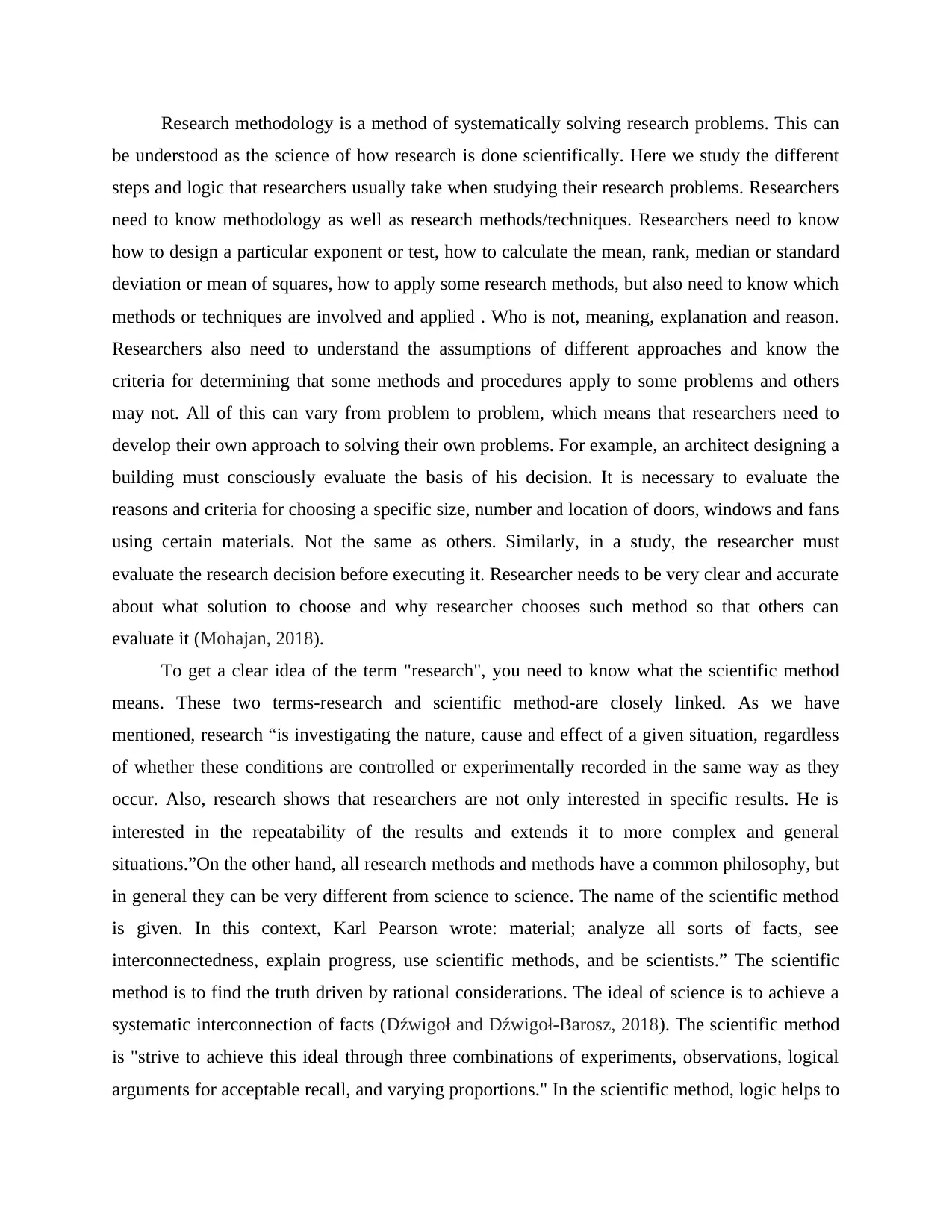
Research methodology is a method of systematically solving research problems. This can
be understood as the science of how research is done scientifically. Here we study the different
steps and logic that researchers usually take when studying their research problems. Researchers
need to know methodology as well as research methods/techniques. Researchers need to know
how to design a particular exponent or test, how to calculate the mean, rank, median or standard
deviation or mean of squares, how to apply some research methods, but also need to know which
methods or techniques are involved and applied . Who is not, meaning, explanation and reason.
Researchers also need to understand the assumptions of different approaches and know the
criteria for determining that some methods and procedures apply to some problems and others
may not. All of this can vary from problem to problem, which means that researchers need to
develop their own approach to solving their own problems. For example, an architect designing a
building must consciously evaluate the basis of his decision. It is necessary to evaluate the
reasons and criteria for choosing a specific size, number and location of doors, windows and fans
using certain materials. Not the same as others. Similarly, in a study, the researcher must
evaluate the research decision before executing it. Researcher needs to be very clear and accurate
about what solution to choose and why researcher chooses such method so that others can
evaluate it (Mohajan, 2018).
To get a clear idea of the term "research", you need to know what the scientific method
means. These two terms-research and scientific method-are closely linked. As we have
mentioned, research “is investigating the nature, cause and effect of a given situation, regardless
of whether these conditions are controlled or experimentally recorded in the same way as they
occur. Also, research shows that researchers are not only interested in specific results. He is
interested in the repeatability of the results and extends it to more complex and general
situations.”On the other hand, all research methods and methods have a common philosophy, but
in general they can be very different from science to science. The name of the scientific method
is given. In this context, Karl Pearson wrote: material; analyze all sorts of facts, see
interconnectedness, explain progress, use scientific methods, and be scientists.” The scientific
method is to find the truth driven by rational considerations. The ideal of science is to achieve a
systematic interconnection of facts (Dźwigoł and Dźwigoł-Barosz, 2018). The scientific method
is "strive to achieve this ideal through three combinations of experiments, observations, logical
arguments for acceptable recall, and varying proportions." In the scientific method, logic helps to
be understood as the science of how research is done scientifically. Here we study the different
steps and logic that researchers usually take when studying their research problems. Researchers
need to know methodology as well as research methods/techniques. Researchers need to know
how to design a particular exponent or test, how to calculate the mean, rank, median or standard
deviation or mean of squares, how to apply some research methods, but also need to know which
methods or techniques are involved and applied . Who is not, meaning, explanation and reason.
Researchers also need to understand the assumptions of different approaches and know the
criteria for determining that some methods and procedures apply to some problems and others
may not. All of this can vary from problem to problem, which means that researchers need to
develop their own approach to solving their own problems. For example, an architect designing a
building must consciously evaluate the basis of his decision. It is necessary to evaluate the
reasons and criteria for choosing a specific size, number and location of doors, windows and fans
using certain materials. Not the same as others. Similarly, in a study, the researcher must
evaluate the research decision before executing it. Researcher needs to be very clear and accurate
about what solution to choose and why researcher chooses such method so that others can
evaluate it (Mohajan, 2018).
To get a clear idea of the term "research", you need to know what the scientific method
means. These two terms-research and scientific method-are closely linked. As we have
mentioned, research “is investigating the nature, cause and effect of a given situation, regardless
of whether these conditions are controlled or experimentally recorded in the same way as they
occur. Also, research shows that researchers are not only interested in specific results. He is
interested in the repeatability of the results and extends it to more complex and general
situations.”On the other hand, all research methods and methods have a common philosophy, but
in general they can be very different from science to science. The name of the scientific method
is given. In this context, Karl Pearson wrote: material; analyze all sorts of facts, see
interconnectedness, explain progress, use scientific methods, and be scientists.” The scientific
method is to find the truth driven by rational considerations. The ideal of science is to achieve a
systematic interconnection of facts (Dźwigoł and Dźwigoł-Barosz, 2018). The scientific method
is "strive to achieve this ideal through three combinations of experiments, observations, logical
arguments for acceptable recall, and varying proportions." In the scientific method, logic helps to
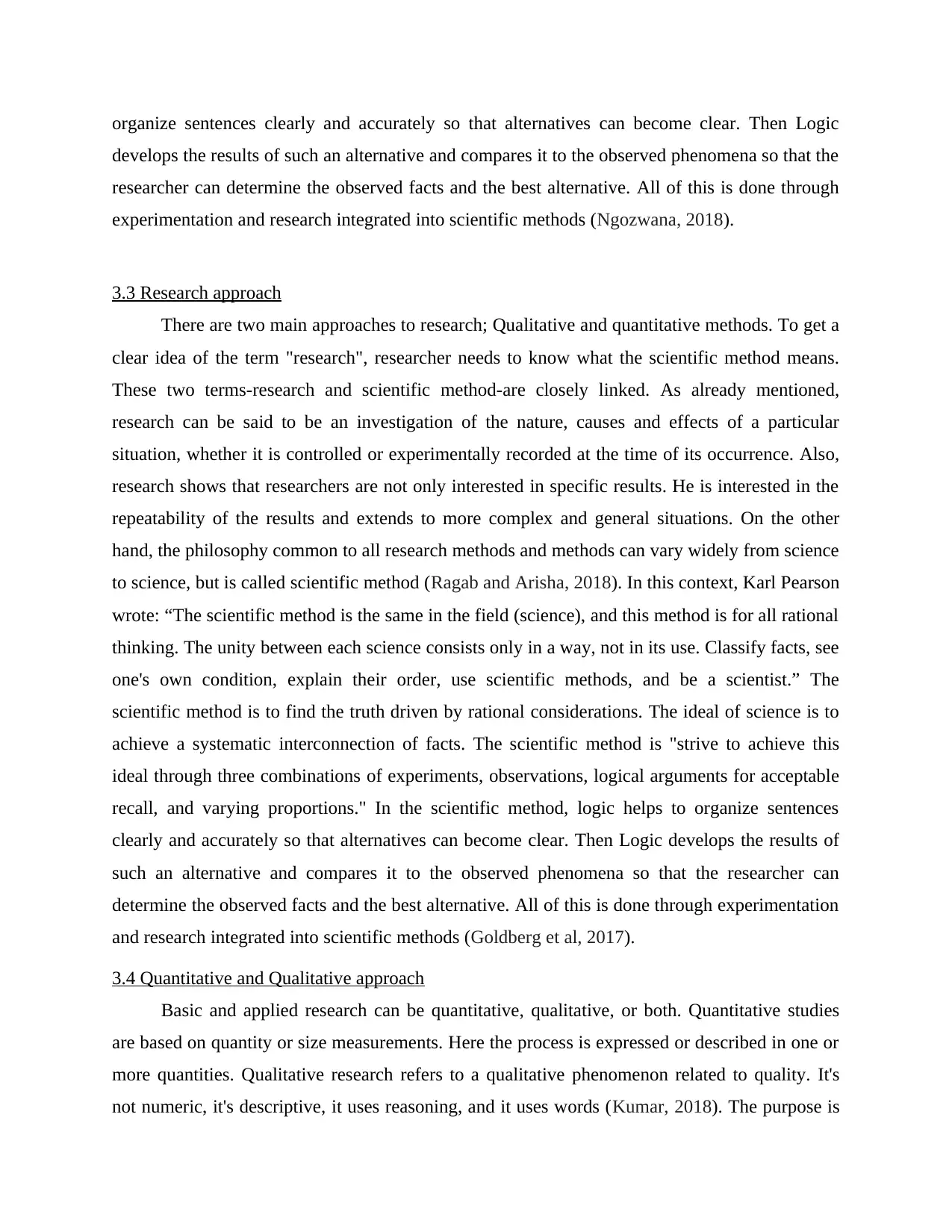
organize sentences clearly and accurately so that alternatives can become clear. Then Logic
develops the results of such an alternative and compares it to the observed phenomena so that the
researcher can determine the observed facts and the best alternative. All of this is done through
experimentation and research integrated into scientific methods (Ngozwana, 2018).
3.3 Research approach
There are two main approaches to research; Qualitative and quantitative methods. To get a
clear idea of the term "research", researcher needs to know what the scientific method means.
These two terms-research and scientific method-are closely linked. As already mentioned,
research can be said to be an investigation of the nature, causes and effects of a particular
situation, whether it is controlled or experimentally recorded at the time of its occurrence. Also,
research shows that researchers are not only interested in specific results. He is interested in the
repeatability of the results and extends to more complex and general situations. On the other
hand, the philosophy common to all research methods and methods can vary widely from science
to science, but is called scientific method (Ragab and Arisha, 2018). In this context, Karl Pearson
wrote: “The scientific method is the same in the field (science), and this method is for all rational
thinking. The unity between each science consists only in a way, not in its use. Classify facts, see
one's own condition, explain their order, use scientific methods, and be a scientist.” The
scientific method is to find the truth driven by rational considerations. The ideal of science is to
achieve a systematic interconnection of facts. The scientific method is "strive to achieve this
ideal through three combinations of experiments, observations, logical arguments for acceptable
recall, and varying proportions." In the scientific method, logic helps to organize sentences
clearly and accurately so that alternatives can become clear. Then Logic develops the results of
such an alternative and compares it to the observed phenomena so that the researcher can
determine the observed facts and the best alternative. All of this is done through experimentation
and research integrated into scientific methods (Goldberg et al, 2017).
3.4 Quantitative and Qualitative approach
Basic and applied research can be quantitative, qualitative, or both. Quantitative studies
are based on quantity or size measurements. Here the process is expressed or described in one or
more quantities. Qualitative research refers to a qualitative phenomenon related to quality. It's
not numeric, it's descriptive, it uses reasoning, and it uses words (Kumar, 2018). The purpose is
develops the results of such an alternative and compares it to the observed phenomena so that the
researcher can determine the observed facts and the best alternative. All of this is done through
experimentation and research integrated into scientific methods (Ngozwana, 2018).
3.3 Research approach
There are two main approaches to research; Qualitative and quantitative methods. To get a
clear idea of the term "research", researcher needs to know what the scientific method means.
These two terms-research and scientific method-are closely linked. As already mentioned,
research can be said to be an investigation of the nature, causes and effects of a particular
situation, whether it is controlled or experimentally recorded at the time of its occurrence. Also,
research shows that researchers are not only interested in specific results. He is interested in the
repeatability of the results and extends to more complex and general situations. On the other
hand, the philosophy common to all research methods and methods can vary widely from science
to science, but is called scientific method (Ragab and Arisha, 2018). In this context, Karl Pearson
wrote: “The scientific method is the same in the field (science), and this method is for all rational
thinking. The unity between each science consists only in a way, not in its use. Classify facts, see
one's own condition, explain their order, use scientific methods, and be a scientist.” The
scientific method is to find the truth driven by rational considerations. The ideal of science is to
achieve a systematic interconnection of facts. The scientific method is "strive to achieve this
ideal through three combinations of experiments, observations, logical arguments for acceptable
recall, and varying proportions." In the scientific method, logic helps to organize sentences
clearly and accurately so that alternatives can become clear. Then Logic develops the results of
such an alternative and compares it to the observed phenomena so that the researcher can
determine the observed facts and the best alternative. All of this is done through experimentation
and research integrated into scientific methods (Goldberg et al, 2017).
3.4 Quantitative and Qualitative approach
Basic and applied research can be quantitative, qualitative, or both. Quantitative studies
are based on quantity or size measurements. Here the process is expressed or described in one or
more quantities. Qualitative research refers to a qualitative phenomenon related to quality. It's
not numeric, it's descriptive, it uses reasoning, and it uses words (Kumar, 2018). The purpose is

to understand the meaning and to feel and explain the situation. Anyone who wants to know why
there is random data is a qualitative approach. If the main goal is to study how random the data is
and what the mean, variance and distribution functions are, then it will be quantitative data. In
recent years, in many social sciences, there has been widespread debate over the relative
advantages of quantitative and qualitative research strategies. The roles individual researchers
take vary considerably, from those who believe that the two strategies are completely separate
and based on an alternative worldview, to those who wish to mix these strategies in a research
project. When studying the differences between qualitative and quantitative forms of research, it
is necessary to take into account different ontological and epistemological issues, as well as
positivism, interpretive and critical paradigms.
3.5 Data collection methods
Data collection is the process of gathering and measuring information about variables of
interest in an established and systematic way to answer research questions, test hypotheses, and
evaluate results. The research component of data collection is common to all fields of study,
including physics and social sciences, humanities, and business. The methods vary by discipline,
but the focus is on ensuring that accurate and fair collections remain the same. The purpose of
collecting all information is to collect high-quality evidence. It is then transformed into detailed
data analysis, providing convincing and reliable answers to your questions. Regardless of the
study area or data definition choice (quantitative or qualitative), accurate data collection is
critical to maintaining the integrity of the study. Choosing an appropriate data collection tool
(existing, modified or newly developed) and well-defined guidelines for proper use will reduce
the likelihood of errors.
There are basically two sources of data collections; primary and secondary. For this thesis,
secondary data have been collected through empirical study of retail market of UK about their
different schemes of loyalty program. The sources of data include websites, online journal
articles, and e-books.
there is random data is a qualitative approach. If the main goal is to study how random the data is
and what the mean, variance and distribution functions are, then it will be quantitative data. In
recent years, in many social sciences, there has been widespread debate over the relative
advantages of quantitative and qualitative research strategies. The roles individual researchers
take vary considerably, from those who believe that the two strategies are completely separate
and based on an alternative worldview, to those who wish to mix these strategies in a research
project. When studying the differences between qualitative and quantitative forms of research, it
is necessary to take into account different ontological and epistemological issues, as well as
positivism, interpretive and critical paradigms.
3.5 Data collection methods
Data collection is the process of gathering and measuring information about variables of
interest in an established and systematic way to answer research questions, test hypotheses, and
evaluate results. The research component of data collection is common to all fields of study,
including physics and social sciences, humanities, and business. The methods vary by discipline,
but the focus is on ensuring that accurate and fair collections remain the same. The purpose of
collecting all information is to collect high-quality evidence. It is then transformed into detailed
data analysis, providing convincing and reliable answers to your questions. Regardless of the
study area or data definition choice (quantitative or qualitative), accurate data collection is
critical to maintaining the integrity of the study. Choosing an appropriate data collection tool
(existing, modified or newly developed) and well-defined guidelines for proper use will reduce
the likelihood of errors.
There are basically two sources of data collections; primary and secondary. For this thesis,
secondary data have been collected through empirical study of retail market of UK about their
different schemes of loyalty program. The sources of data include websites, online journal
articles, and e-books.
Secure Best Marks with AI Grader
Need help grading? Try our AI Grader for instant feedback on your assignments.

4. Analysis
4.1 Introduction
This section consists of result obtained from secondary research on outcome from
application of loyalty programmes scheme by different retail stores in the form of retaining of
customers. This section will also show empirical result received from the research on Tesco
company which is a big retail store operating in UK and other parts of the world; but for this
research UK based Tesco has been considered.
4.2 Findings
Emerald insight is a webpage which gives journals, books, and case studies (). The
interview result with Clive Humby, chairman of Dunnhumby and a customer insight specialist.
Tesco is also part of one of Clive’s client list. The result shows that a key factor in Tesco's
success was the drive to use data to run the business. Many companies have used the loyalty
system as a kind of quick problem solving and marketing tool. Loyalty systems are, in some
ways, a form of marketing, but they are expensive. The real advantage of the loyalty system is
that you have very rich customer data. This data improves the ability of retailers to make their
purchases more attractive by offering the right product on the shelf at the right price and at the
right promotion. This use of data was an important difference in Tesco's design from other less
successful companies.
Tesco sells tens of millions of units per week. To understand all of this, you need to focus
entirely on using the right data. Many companies collect this information, but they do not
intentionally use it daily and weekly. They spend tens of millions of pounds on data collection,
but aren't ready to spend millions of pounds analyzing the information received. They try to take
advantage of the effects of promotional and loyalty programs that never work. You only need to
measure a certain cost and sales volume. If the sales achieved don't increase, then the loyalty
program isn't working properly and much more analysis is needed.
The peaks and declines of weekly shopping are inevitable, but there are key trends that
can be recognized over time. Changes in the family, for example, lead to a decrease in the basket
leading to an increase. For example, data analysis can tell when children have left their home to
say that their pizza purchase is over.
4.1 Introduction
This section consists of result obtained from secondary research on outcome from
application of loyalty programmes scheme by different retail stores in the form of retaining of
customers. This section will also show empirical result received from the research on Tesco
company which is a big retail store operating in UK and other parts of the world; but for this
research UK based Tesco has been considered.
4.2 Findings
Emerald insight is a webpage which gives journals, books, and case studies (). The
interview result with Clive Humby, chairman of Dunnhumby and a customer insight specialist.
Tesco is also part of one of Clive’s client list. The result shows that a key factor in Tesco's
success was the drive to use data to run the business. Many companies have used the loyalty
system as a kind of quick problem solving and marketing tool. Loyalty systems are, in some
ways, a form of marketing, but they are expensive. The real advantage of the loyalty system is
that you have very rich customer data. This data improves the ability of retailers to make their
purchases more attractive by offering the right product on the shelf at the right price and at the
right promotion. This use of data was an important difference in Tesco's design from other less
successful companies.
Tesco sells tens of millions of units per week. To understand all of this, you need to focus
entirely on using the right data. Many companies collect this information, but they do not
intentionally use it daily and weekly. They spend tens of millions of pounds on data collection,
but aren't ready to spend millions of pounds analyzing the information received. They try to take
advantage of the effects of promotional and loyalty programs that never work. You only need to
measure a certain cost and sales volume. If the sales achieved don't increase, then the loyalty
program isn't working properly and much more analysis is needed.
The peaks and declines of weekly shopping are inevitable, but there are key trends that
can be recognized over time. Changes in the family, for example, lead to a decrease in the basket
leading to an increase. For example, data analysis can tell when children have left their home to
say that their pizza purchase is over.
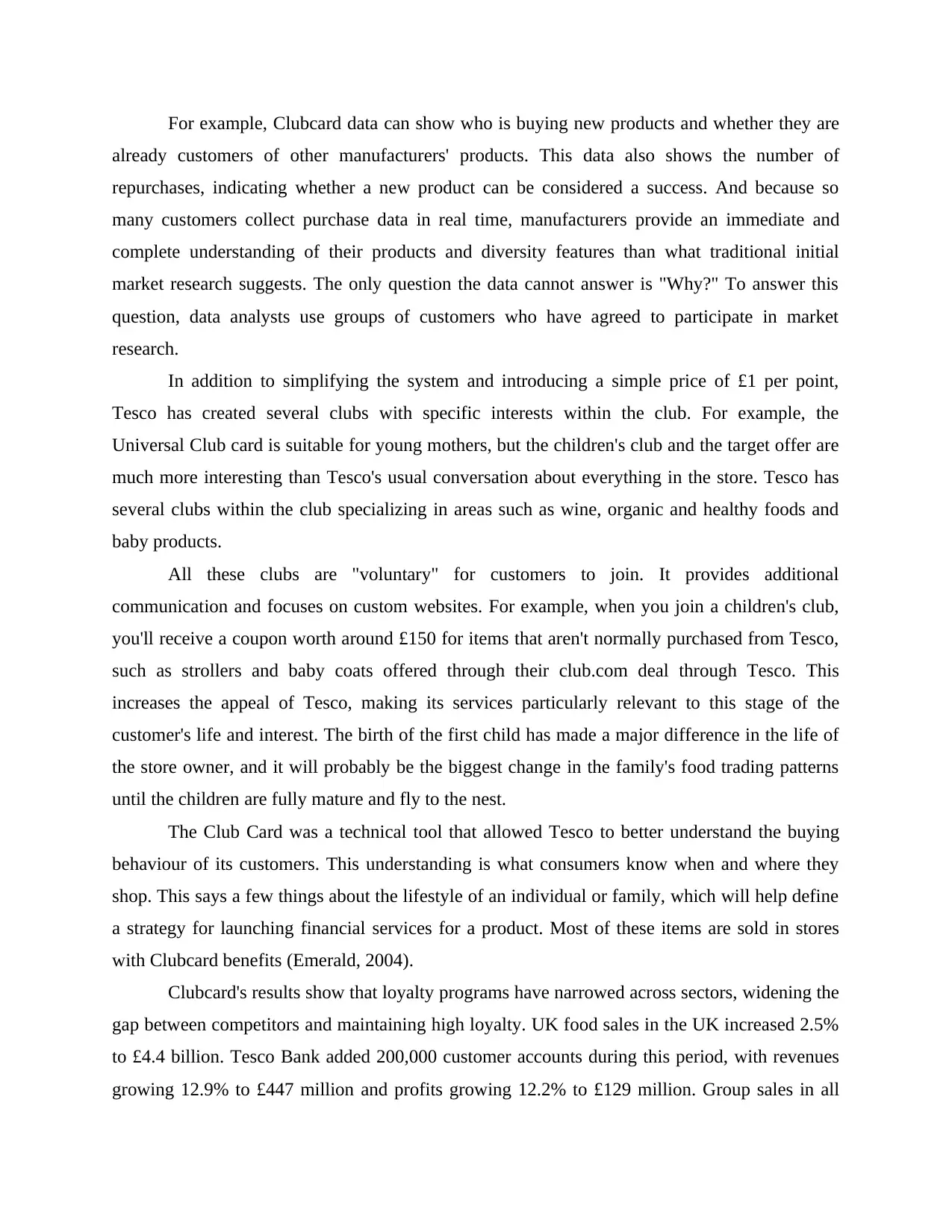
For example, Clubcard data can show who is buying new products and whether they are
already customers of other manufacturers' products. This data also shows the number of
repurchases, indicating whether a new product can be considered a success. And because so
many customers collect purchase data in real time, manufacturers provide an immediate and
complete understanding of their products and diversity features than what traditional initial
market research suggests. The only question the data cannot answer is "Why?" To answer this
question, data analysts use groups of customers who have agreed to participate in market
research.
In addition to simplifying the system and introducing a simple price of £1 per point,
Tesco has created several clubs with specific interests within the club. For example, the
Universal Club card is suitable for young mothers, but the children's club and the target offer are
much more interesting than Tesco's usual conversation about everything in the store. Tesco has
several clubs within the club specializing in areas such as wine, organic and healthy foods and
baby products.
All these clubs are "voluntary" for customers to join. It provides additional
communication and focuses on custom websites. For example, when you join a children's club,
you'll receive a coupon worth around £150 for items that aren't normally purchased from Tesco,
such as strollers and baby coats offered through their club.com deal through Tesco. This
increases the appeal of Tesco, making its services particularly relevant to this stage of the
customer's life and interest. The birth of the first child has made a major difference in the life of
the store owner, and it will probably be the biggest change in the family's food trading patterns
until the children are fully mature and fly to the nest.
The Club Card was a technical tool that allowed Tesco to better understand the buying
behaviour of its customers. This understanding is what consumers know when and where they
shop. This says a few things about the lifestyle of an individual or family, which will help define
a strategy for launching financial services for a product. Most of these items are sold in stores
with Clubcard benefits (Emerald, 2004).
Clubcard's results show that loyalty programs have narrowed across sectors, widening the
gap between competitors and maintaining high loyalty. UK food sales in the UK increased 2.5%
to £4.4 billion. Tesco Bank added 200,000 customer accounts during this period, with revenues
growing 12.9% to £447 million and profits growing 12.2% to £129 million. Group sales in all
already customers of other manufacturers' products. This data also shows the number of
repurchases, indicating whether a new product can be considered a success. And because so
many customers collect purchase data in real time, manufacturers provide an immediate and
complete understanding of their products and diversity features than what traditional initial
market research suggests. The only question the data cannot answer is "Why?" To answer this
question, data analysts use groups of customers who have agreed to participate in market
research.
In addition to simplifying the system and introducing a simple price of £1 per point,
Tesco has created several clubs with specific interests within the club. For example, the
Universal Club card is suitable for young mothers, but the children's club and the target offer are
much more interesting than Tesco's usual conversation about everything in the store. Tesco has
several clubs within the club specializing in areas such as wine, organic and healthy foods and
baby products.
All these clubs are "voluntary" for customers to join. It provides additional
communication and focuses on custom websites. For example, when you join a children's club,
you'll receive a coupon worth around £150 for items that aren't normally purchased from Tesco,
such as strollers and baby coats offered through their club.com deal through Tesco. This
increases the appeal of Tesco, making its services particularly relevant to this stage of the
customer's life and interest. The birth of the first child has made a major difference in the life of
the store owner, and it will probably be the biggest change in the family's food trading patterns
until the children are fully mature and fly to the nest.
The Club Card was a technical tool that allowed Tesco to better understand the buying
behaviour of its customers. This understanding is what consumers know when and where they
shop. This says a few things about the lifestyle of an individual or family, which will help define
a strategy for launching financial services for a product. Most of these items are sold in stores
with Clubcard benefits (Emerald, 2004).
Clubcard's results show that loyalty programs have narrowed across sectors, widening the
gap between competitors and maintaining high loyalty. UK food sales in the UK increased 2.5%
to £4.4 billion. Tesco Bank added 200,000 customer accounts during this period, with revenues
growing 12.9% to £447 million and profits growing 12.2% to £129 million. Group sales in all
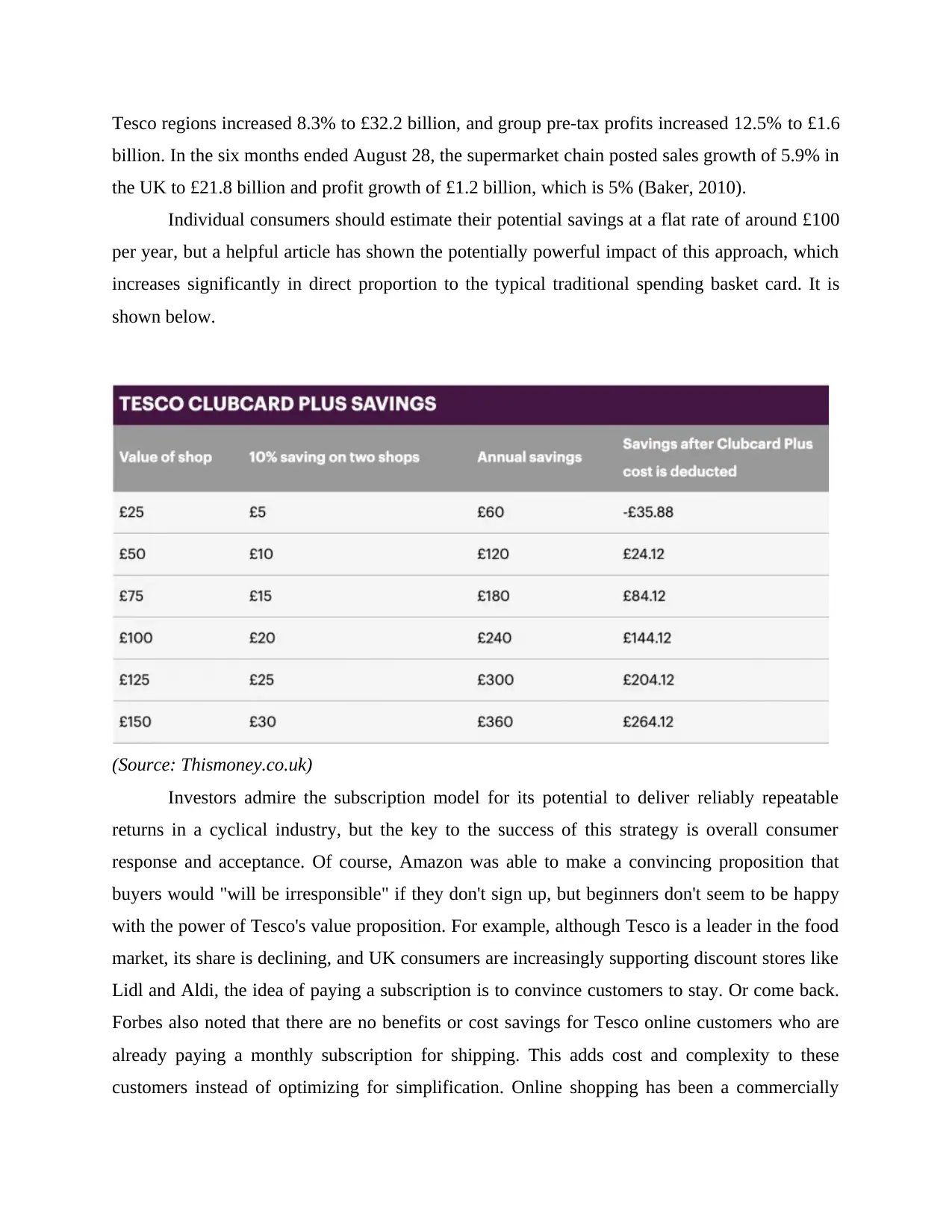
Tesco regions increased 8.3% to £32.2 billion, and group pre-tax profits increased 12.5% to £1.6
billion. In the six months ended August 28, the supermarket chain posted sales growth of 5.9% in
the UK to £21.8 billion and profit growth of £1.2 billion, which is 5% (Baker, 2010).
Individual consumers should estimate their potential savings at a flat rate of around £100
per year, but a helpful article has shown the potentially powerful impact of this approach, which
increases significantly in direct proportion to the typical traditional spending basket card. It is
shown below.
(Source: Thismoney.co.uk)
Investors admire the subscription model for its potential to deliver reliably repeatable
returns in a cyclical industry, but the key to the success of this strategy is overall consumer
response and acceptance. Of course, Amazon was able to make a convincing proposition that
buyers would "will be irresponsible" if they don't sign up, but beginners don't seem to be happy
with the power of Tesco's value proposition. For example, although Tesco is a leader in the food
market, its share is declining, and UK consumers are increasingly supporting discount stores like
Lidl and Aldi, the idea of paying a subscription is to convince customers to stay. Or come back.
Forbes also noted that there are no benefits or cost savings for Tesco online customers who are
already paying a monthly subscription for shipping. This adds cost and complexity to these
customers instead of optimizing for simplification. Online shopping has been a commercially
billion. In the six months ended August 28, the supermarket chain posted sales growth of 5.9% in
the UK to £21.8 billion and profit growth of £1.2 billion, which is 5% (Baker, 2010).
Individual consumers should estimate their potential savings at a flat rate of around £100
per year, but a helpful article has shown the potentially powerful impact of this approach, which
increases significantly in direct proportion to the typical traditional spending basket card. It is
shown below.
(Source: Thismoney.co.uk)
Investors admire the subscription model for its potential to deliver reliably repeatable
returns in a cyclical industry, but the key to the success of this strategy is overall consumer
response and acceptance. Of course, Amazon was able to make a convincing proposition that
buyers would "will be irresponsible" if they don't sign up, but beginners don't seem to be happy
with the power of Tesco's value proposition. For example, although Tesco is a leader in the food
market, its share is declining, and UK consumers are increasingly supporting discount stores like
Lidl and Aldi, the idea of paying a subscription is to convince customers to stay. Or come back.
Forbes also noted that there are no benefits or cost savings for Tesco online customers who are
already paying a monthly subscription for shipping. This adds cost and complexity to these
customers instead of optimizing for simplification. Online shopping has been a commercially
Paraphrase This Document
Need a fresh take? Get an instant paraphrase of this document with our AI Paraphraser
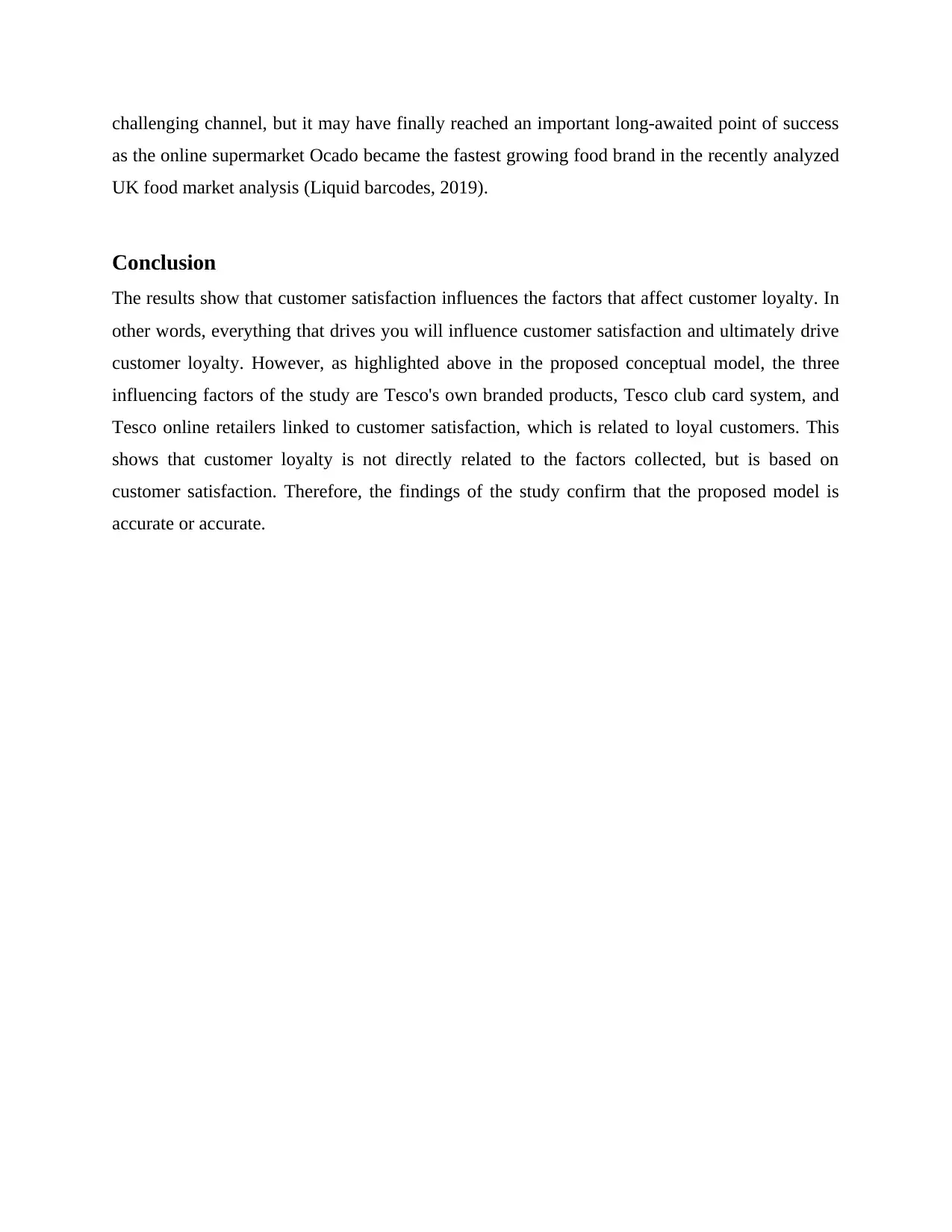
challenging channel, but it may have finally reached an important long-awaited point of success
as the online supermarket Ocado became the fastest growing food brand in the recently analyzed
UK food market analysis (Liquid barcodes, 2019).
Conclusion
The results show that customer satisfaction influences the factors that affect customer loyalty. In
other words, everything that drives you will influence customer satisfaction and ultimately drive
customer loyalty. However, as highlighted above in the proposed conceptual model, the three
influencing factors of the study are Tesco's own branded products, Tesco club card system, and
Tesco online retailers linked to customer satisfaction, which is related to loyal customers. This
shows that customer loyalty is not directly related to the factors collected, but is based on
customer satisfaction. Therefore, the findings of the study confirm that the proposed model is
accurate or accurate.
as the online supermarket Ocado became the fastest growing food brand in the recently analyzed
UK food market analysis (Liquid barcodes, 2019).
Conclusion
The results show that customer satisfaction influences the factors that affect customer loyalty. In
other words, everything that drives you will influence customer satisfaction and ultimately drive
customer loyalty. However, as highlighted above in the proposed conceptual model, the three
influencing factors of the study are Tesco's own branded products, Tesco club card system, and
Tesco online retailers linked to customer satisfaction, which is related to loyal customers. This
shows that customer loyalty is not directly related to the factors collected, but is based on
customer satisfaction. Therefore, the findings of the study confirm that the proposed model is
accurate or accurate.
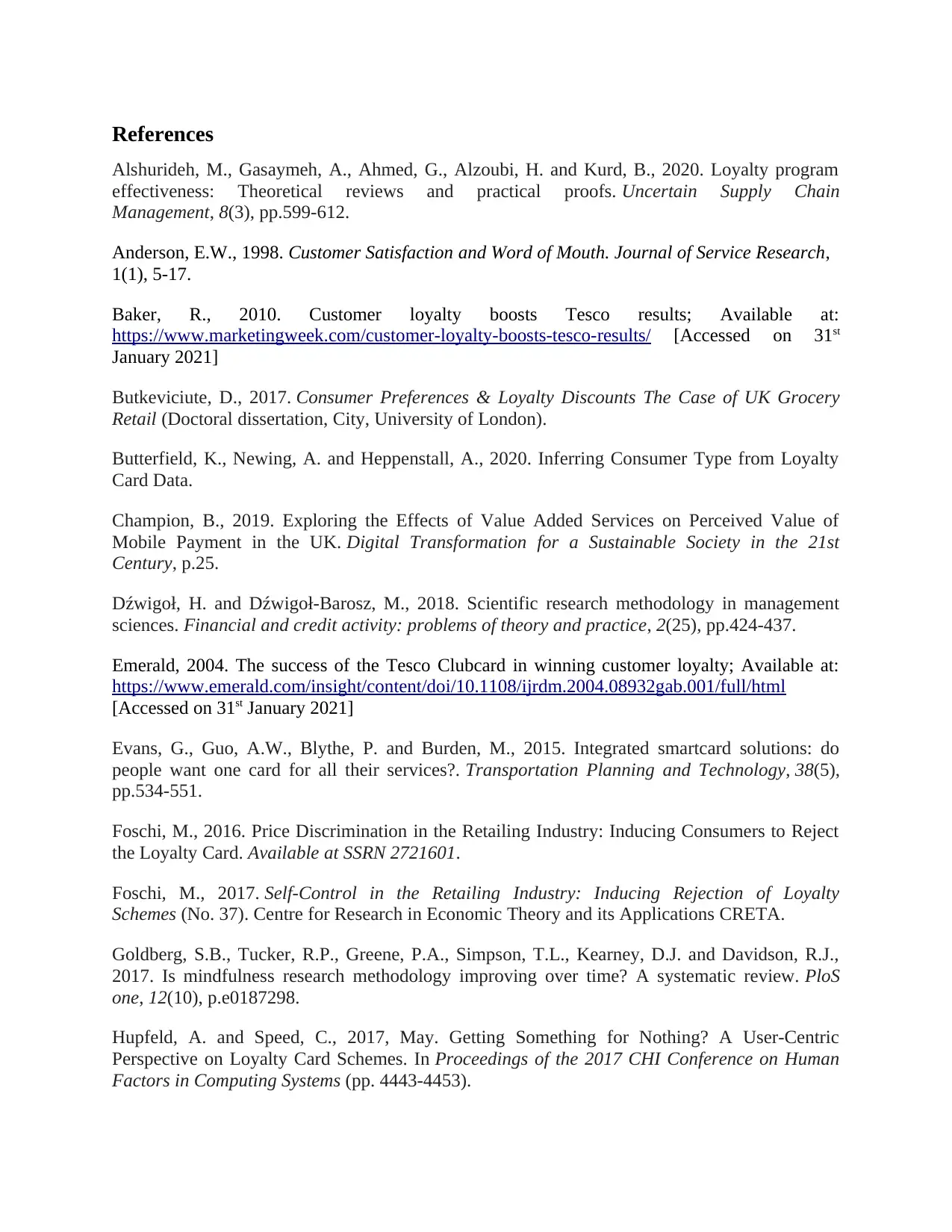
References
Alshurideh, M., Gasaymeh, A., Ahmed, G., Alzoubi, H. and Kurd, B., 2020. Loyalty program
effectiveness: Theoretical reviews and practical proofs. Uncertain Supply Chain
Management, 8(3), pp.599-612.
Anderson, E.W., 1998. Customer Satisfaction and Word of Mouth. Journal of Service Research,
1(1), 5-17.
Baker, R., 2010. Customer loyalty boosts Tesco results; Available at:
https://www.marketingweek.com/customer-loyalty-boosts-tesco-results/ [Accessed on 31st
January 2021]
Butkeviciute, D., 2017. Consumer Preferences & Loyalty Discounts The Case of UK Grocery
Retail (Doctoral dissertation, City, University of London).
Butterfield, K., Newing, A. and Heppenstall, A., 2020. Inferring Consumer Type from Loyalty
Card Data.
Champion, B., 2019. Exploring the Effects of Value Added Services on Perceived Value of
Mobile Payment in the UK. Digital Transformation for a Sustainable Society in the 21st
Century, p.25.
Dźwigoł, H. and Dźwigoł-Barosz, M., 2018. Scientific research methodology in management
sciences. Financial and credit activity: problems of theory and practice, 2(25), pp.424-437.
Emerald, 2004. The success of the Tesco Clubcard in winning customer loyalty; Available at:
https://www.emerald.com/insight/content/doi/10.1108/ijrdm.2004.08932gab.001/full/html
[Accessed on 31st January 2021]
Evans, G., Guo, A.W., Blythe, P. and Burden, M., 2015. Integrated smartcard solutions: do
people want one card for all their services?. Transportation Planning and Technology, 38(5),
pp.534-551.
Foschi, M., 2016. Price Discrimination in the Retailing Industry: Inducing Consumers to Reject
the Loyalty Card. Available at SSRN 2721601.
Foschi, M., 2017. Self-Control in the Retailing Industry: Inducing Rejection of Loyalty
Schemes (No. 37). Centre for Research in Economic Theory and its Applications CRETA.
Goldberg, S.B., Tucker, R.P., Greene, P.A., Simpson, T.L., Kearney, D.J. and Davidson, R.J.,
2017. Is mindfulness research methodology improving over time? A systematic review. PloS
one, 12(10), p.e0187298.
Hupfeld, A. and Speed, C., 2017, May. Getting Something for Nothing? A User-Centric
Perspective on Loyalty Card Schemes. In Proceedings of the 2017 CHI Conference on Human
Factors in Computing Systems (pp. 4443-4453).
Alshurideh, M., Gasaymeh, A., Ahmed, G., Alzoubi, H. and Kurd, B., 2020. Loyalty program
effectiveness: Theoretical reviews and practical proofs. Uncertain Supply Chain
Management, 8(3), pp.599-612.
Anderson, E.W., 1998. Customer Satisfaction and Word of Mouth. Journal of Service Research,
1(1), 5-17.
Baker, R., 2010. Customer loyalty boosts Tesco results; Available at:
https://www.marketingweek.com/customer-loyalty-boosts-tesco-results/ [Accessed on 31st
January 2021]
Butkeviciute, D., 2017. Consumer Preferences & Loyalty Discounts The Case of UK Grocery
Retail (Doctoral dissertation, City, University of London).
Butterfield, K., Newing, A. and Heppenstall, A., 2020. Inferring Consumer Type from Loyalty
Card Data.
Champion, B., 2019. Exploring the Effects of Value Added Services on Perceived Value of
Mobile Payment in the UK. Digital Transformation for a Sustainable Society in the 21st
Century, p.25.
Dźwigoł, H. and Dźwigoł-Barosz, M., 2018. Scientific research methodology in management
sciences. Financial and credit activity: problems of theory and practice, 2(25), pp.424-437.
Emerald, 2004. The success of the Tesco Clubcard in winning customer loyalty; Available at:
https://www.emerald.com/insight/content/doi/10.1108/ijrdm.2004.08932gab.001/full/html
[Accessed on 31st January 2021]
Evans, G., Guo, A.W., Blythe, P. and Burden, M., 2015. Integrated smartcard solutions: do
people want one card for all their services?. Transportation Planning and Technology, 38(5),
pp.534-551.
Foschi, M., 2016. Price Discrimination in the Retailing Industry: Inducing Consumers to Reject
the Loyalty Card. Available at SSRN 2721601.
Foschi, M., 2017. Self-Control in the Retailing Industry: Inducing Rejection of Loyalty
Schemes (No. 37). Centre for Research in Economic Theory and its Applications CRETA.
Goldberg, S.B., Tucker, R.P., Greene, P.A., Simpson, T.L., Kearney, D.J. and Davidson, R.J.,
2017. Is mindfulness research methodology improving over time? A systematic review. PloS
one, 12(10), p.e0187298.
Hupfeld, A. and Speed, C., 2017, May. Getting Something for Nothing? A User-Centric
Perspective on Loyalty Card Schemes. In Proceedings of the 2017 CHI Conference on Human
Factors in Computing Systems (pp. 4443-4453).
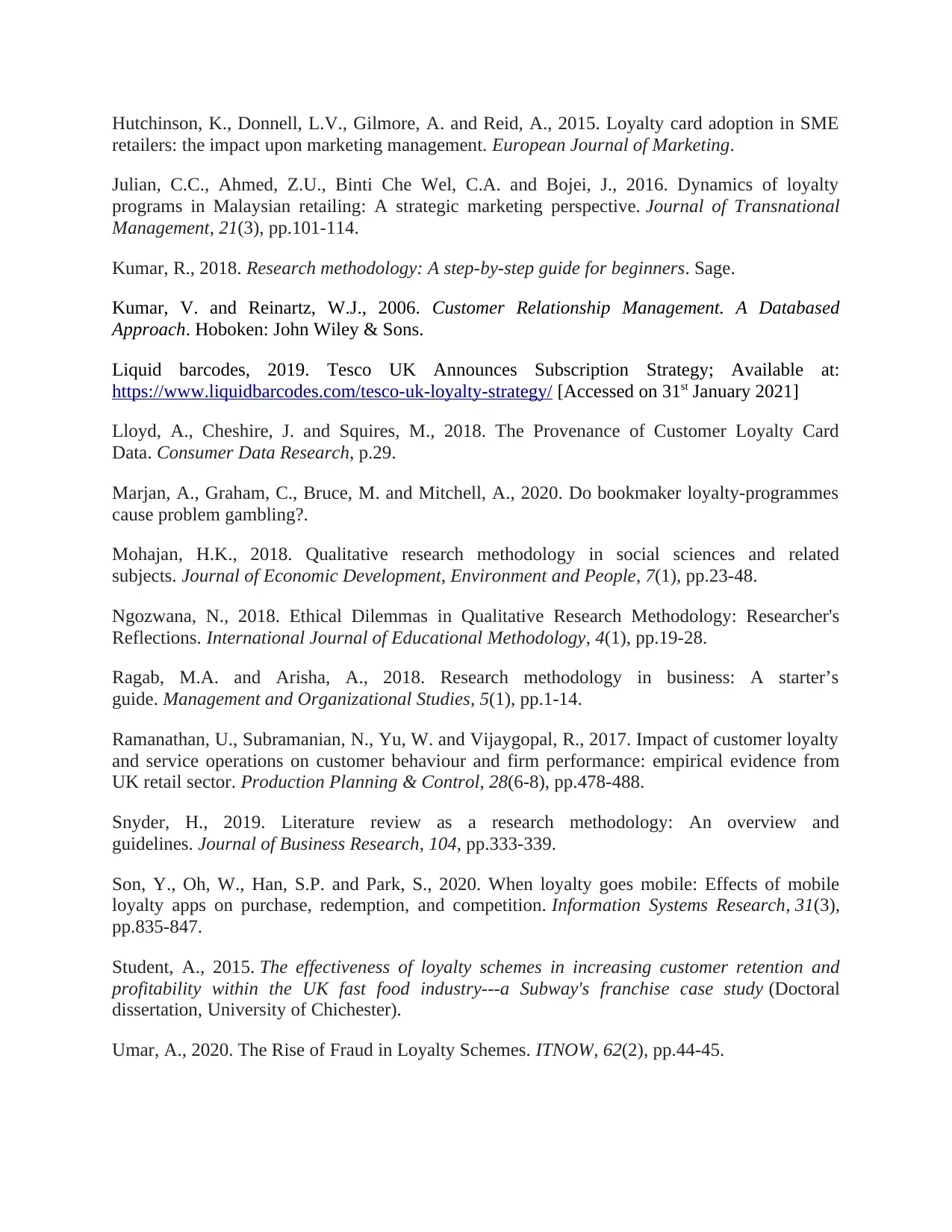
Hutchinson, K., Donnell, L.V., Gilmore, A. and Reid, A., 2015. Loyalty card adoption in SME
retailers: the impact upon marketing management. European Journal of Marketing.
Julian, C.C., Ahmed, Z.U., Binti Che Wel, C.A. and Bojei, J., 2016. Dynamics of loyalty
programs in Malaysian retailing: A strategic marketing perspective. Journal of Transnational
Management, 21(3), pp.101-114.
Kumar, R., 2018. Research methodology: A step-by-step guide for beginners. Sage.
Kumar, V. and Reinartz, W.J., 2006. Customer Relationship Management. A Databased
Approach. Hoboken: John Wiley & Sons.
Liquid barcodes, 2019. Tesco UK Announces Subscription Strategy; Available at:
https://www.liquidbarcodes.com/tesco-uk-loyalty-strategy/ [Accessed on 31st January 2021]
Lloyd, A., Cheshire, J. and Squires, M., 2018. The Provenance of Customer Loyalty Card
Data. Consumer Data Research, p.29.
Marjan, A., Graham, C., Bruce, M. and Mitchell, A., 2020. Do bookmaker loyalty-programmes
cause problem gambling?.
Mohajan, H.K., 2018. Qualitative research methodology in social sciences and related
subjects. Journal of Economic Development, Environment and People, 7(1), pp.23-48.
Ngozwana, N., 2018. Ethical Dilemmas in Qualitative Research Methodology: Researcher's
Reflections. International Journal of Educational Methodology, 4(1), pp.19-28.
Ragab, M.A. and Arisha, A., 2018. Research methodology in business: A starter’s
guide. Management and Organizational Studies, 5(1), pp.1-14.
Ramanathan, U., Subramanian, N., Yu, W. and Vijaygopal, R., 2017. Impact of customer loyalty
and service operations on customer behaviour and firm performance: empirical evidence from
UK retail sector. Production Planning & Control, 28(6-8), pp.478-488.
Snyder, H., 2019. Literature review as a research methodology: An overview and
guidelines. Journal of Business Research, 104, pp.333-339.
Son, Y., Oh, W., Han, S.P. and Park, S., 2020. When loyalty goes mobile: Effects of mobile
loyalty apps on purchase, redemption, and competition. Information Systems Research, 31(3),
pp.835-847.
Student, A., 2015. The effectiveness of loyalty schemes in increasing customer retention and
profitability within the UK fast food industry---a Subway's franchise case study (Doctoral
dissertation, University of Chichester).
Umar, A., 2020. The Rise of Fraud in Loyalty Schemes. ITNOW, 62(2), pp.44-45.
retailers: the impact upon marketing management. European Journal of Marketing.
Julian, C.C., Ahmed, Z.U., Binti Che Wel, C.A. and Bojei, J., 2016. Dynamics of loyalty
programs in Malaysian retailing: A strategic marketing perspective. Journal of Transnational
Management, 21(3), pp.101-114.
Kumar, R., 2018. Research methodology: A step-by-step guide for beginners. Sage.
Kumar, V. and Reinartz, W.J., 2006. Customer Relationship Management. A Databased
Approach. Hoboken: John Wiley & Sons.
Liquid barcodes, 2019. Tesco UK Announces Subscription Strategy; Available at:
https://www.liquidbarcodes.com/tesco-uk-loyalty-strategy/ [Accessed on 31st January 2021]
Lloyd, A., Cheshire, J. and Squires, M., 2018. The Provenance of Customer Loyalty Card
Data. Consumer Data Research, p.29.
Marjan, A., Graham, C., Bruce, M. and Mitchell, A., 2020. Do bookmaker loyalty-programmes
cause problem gambling?.
Mohajan, H.K., 2018. Qualitative research methodology in social sciences and related
subjects. Journal of Economic Development, Environment and People, 7(1), pp.23-48.
Ngozwana, N., 2018. Ethical Dilemmas in Qualitative Research Methodology: Researcher's
Reflections. International Journal of Educational Methodology, 4(1), pp.19-28.
Ragab, M.A. and Arisha, A., 2018. Research methodology in business: A starter’s
guide. Management and Organizational Studies, 5(1), pp.1-14.
Ramanathan, U., Subramanian, N., Yu, W. and Vijaygopal, R., 2017. Impact of customer loyalty
and service operations on customer behaviour and firm performance: empirical evidence from
UK retail sector. Production Planning & Control, 28(6-8), pp.478-488.
Snyder, H., 2019. Literature review as a research methodology: An overview and
guidelines. Journal of Business Research, 104, pp.333-339.
Son, Y., Oh, W., Han, S.P. and Park, S., 2020. When loyalty goes mobile: Effects of mobile
loyalty apps on purchase, redemption, and competition. Information Systems Research, 31(3),
pp.835-847.
Student, A., 2015. The effectiveness of loyalty schemes in increasing customer retention and
profitability within the UK fast food industry---a Subway's franchise case study (Doctoral
dissertation, University of Chichester).
Umar, A., 2020. The Rise of Fraud in Loyalty Schemes. ITNOW, 62(2), pp.44-45.
Secure Best Marks with AI Grader
Need help grading? Try our AI Grader for instant feedback on your assignments.

Zielke, S. and Komor, M., 2020. Loyalty cards, credit options and economic market
development. International Journal of Retail & Distribution Management.
development. International Journal of Retail & Distribution Management.


Paraphrase This Document
Need a fresh take? Get an instant paraphrase of this document with our AI Paraphraser

1 out of 29
Related Documents
Your All-in-One AI-Powered Toolkit for Academic Success.
+13062052269
info@desklib.com
Available 24*7 on WhatsApp / Email
![[object Object]](/_next/static/media/star-bottom.7253800d.svg)
Unlock your academic potential
© 2024 | Zucol Services PVT LTD | All rights reserved.



